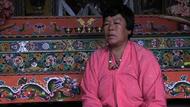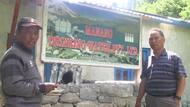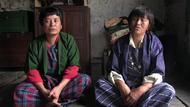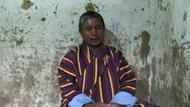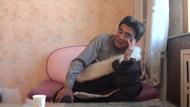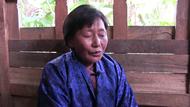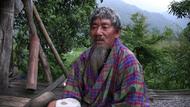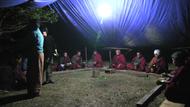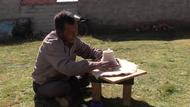Video Overview
This title is an interview which describes the history of the Degé Printing House.
- Kandzé Tibetan Autonomous Prefecture
- དགེ་འདུན་ Monkལྟ་སྡེ་དགེ་ས་གནས་དེ་ཉིད་ཀྱི་མི་རེད་པཱ། དེ་ནས་ཨང་རང་གི་ཕ་ནི་མི་[མི་གསལ་]དགུ་ཟེར། ཨང་དེ་ནས་བསྟེན་ནས་དམ་པ་ཆོས་དང་དྲུག་ར་ཅིག་ཡོད་རེད། ཆབ་སྲིད་གྲོས་མོལ་ཨུ་ཡོན་ལྷན་ཁང་ནང་ལ་ཡོད། དེ་ནས་ས་གནས་དེ་ནས་ཀྱི་ལྟ་ངའི་ཨ་མ། སྐལ་བཟང་སྒྲོལ་མ་ཟེར། ཁོང་རྣམ་པ་གཉིས་ཐུག་འགྲོI am from Degé. My father, a government official who had served in the regional Political Consultancy Committee. He met my mother, Kelzang Drölma, here in Degé.
- དེ་ནས་ང་རང་ཤེས་རིག་གི་དུས་ཚོད་ར་ཡིན་ན་༡༩༧༡ལོར་རང་གི་ཕ་སྤྲུལ་སྐུ་རིན་པོ་ཆེའི་མདུན་ནས་ལྟ་ཡི་གེ་འབྲི་ཀློག་ལ་སློབ་གཉེར་བྱས། དེ་ནས་ལོ་༡༢ཀྱི་དུས་སུ་དེ་ནས་བོན་པོ་ཀྱི་[ཡི་]བླ་མ་རྩ་ཆེ་ཤོས་གྲུབ་ཆེན་ཉི་མ་རིན་པོ་ཆེ་ཟེར་མཁན་དེ་ཡིས་དེ་ནས་མཐའ་དེའི་དགོན་པའི་སྤྲུལ་སྐུ་གཡུང་དྲུང་བདེ་འཇགས་ཡང་སྲིད་ཡིན་ཞེས་ངོས་འཛིན་བཟུང་།My education began in 1971. I learned how to read and write from father who is also a rinpiché. At the age of twelve, one of the holiest Bön masters called Drupchen Nyima Rinpoché recognized me as the reincarnation of another Bön master named Trülku Yungdrung Déjak.
- དེ་ནས་བཟུང་སྟེ་དེ་ནས་རང་གི་དགོན་པའི་ནང་ལ་དེ་ནས་གསོ་སྦྱོང་བྱེད་ཡག་རེད། རིག་གནས། བོན་པོའི་ཕྱི་ནང་གི་རིག་གནས། གཙོ་བོ་ལྟ་སྤྲུལ་སྐུ་ཞིག་བྱེད་དུས་དེ་ནང་ལའི་ལྟ་དགོན་པོའི་ནང་ལ་སློབ་གཉེར་བྱེད་ཆ་རྐྱེན་ཏིག་ཙམ་ཞན་འགྲོ་ན་སྡེ་དགེ་རྫོང་ཁག་ལ་དེ་ནས་དགེ་རྒན་མང་གི་མདུན་དུ་ལྟ་རིག་པའི་གནས་ལྔ་ལ་སློབ་གཉེར་དང་།From that time onward, I started my religious training in my Bön monastery, studying every expect of the Bön culture. At the time, the education facilities in the monastery were quite poor. I studied the Five Sciences under the teachings of many masters in the Degé area.
- དེ་ནས་ཕྱིས་སུ་དེ་ནས་ཤར་རྫ་འདྲ་ལ་བགྲོད། ལྟ་མདོ་དབུས་ཁམས་གསུམ་ལ་བོན་པོའང་གྲྭ་ས་གོང་འོག་བར་གསུམ་ཡོད་རེད། དེའི་ནང་ནས་ཁམས་ཕྱོགས་ཀྱི་གྲྭ་ས་ཆེ་ཤོས་དེ་ལྟ་ཤར་རྫ་ཟེར་དེ་ན་རེད། དེ་ནང་དུ་རྫོགས་ཆེན་གྱི་སྐོར་ལ་ཉམས་ལེན། གཙོ་བོ་ལྟ་སྔོན་འགྲོ་གཟབ་སྦྱོང་དང་། སྔོན་འགྲོ་འདི་ལོ་ཧ་ལམ་བཞི་ཙམ་ཞིག་བྱས་པ་རེད།Later I went to Shardza monastery. In three provinces of Tibet, the Bön tradition also has its upper, middle, and lower monastic learning centers. In Kham area, Shardza the biggest one. At that Bön learning center, I mainly focused on the [Bön] Great Perfection, beginning from the preliminary stage which took me four years to complete it.
- དེ་ནས་དེའི་རྗེས་སུ་ལ་རང་གི་དགོན་པའི་ནང་ཕར་སོང་ནས། དེ་ནས་དགོན་པའི་གྲུབ་དག་ཆེན་པོ་་་ཡོད་དེ་རེད་པ། དེ་ཡིན་དུས་དེའི་ནང་ལ་མིང་ལ་དཔལ་གཡུ་རྙིང་མའི་ཕྱོགས། རྨུ་གསུམ་ཟེར་ཡག་དེ་ཚོ་ལའི་རྙིང་མའི་གྱི་སྐོར་ལ་སློབ་གཉེར་ཏིག་ཙམ་བྱེད་ཡག་དང་། སྐབས་སྐབས་སུ་སྡེ་དགེ་རྫོང་རང་བསྡད། དགོན་ཆེན་དེ་ས་ཆ་ཡི་དགོན་པ་རེད་དུས་དེའི་སྐོར་ལ་དབང་ལུང་ཁྲིད་གསུམ་ལ་ཏིག་ཙམ།After completing that, I returned to my monastery and studied a little bit about Nyingma. Sometimes I would spend my time in the Degé area, receiving empowerments, transmissions, and instructions from my masters.
- ལྟ་རིག་གནས་ལ་སློབ་སྦྱོང་ར་བྱས། ལོ་ཕྲག་གཅིག་འདི་འདྲས་བྱས། ་་རྒན་པས་ལྟ་གི་ཡོད་རེད། དེ་ནས་ཀུན་གཟིགས་པཎ་ཆེན་རིན་པོ་ཆེ་མཆོག་གིས་དེ་ནས་རིག་གནས་ཀྱི་སློབ་གྲྭ་ཆེན་པོ་ཞིག་བརྒྱབ། དེའི་ནང་གཅིག་སོང་ན་ཡག་པོ་ཡོང་ས་རེད་བསམས། དེ་ནས་ཕྱིས་སུ་ཁོ་ཚོ་འདི་གི་ཆོག་མཁན་ར་དེ་འགྲོ་ཆོག་གསུངས། དེ་ནས་ང་རང་འགྲོ་མོས་ཡོད་དེ་ནས་པེ་ཅིང་ལ་སོང་བ་རེད།So like that, spent about a decade to studies under senior monks. Later, Panchen Rinpoché [10th Panchen Lama] established a college for higher cultural studies. I thought that I would be wonderful if I could study there for a year or so. I got permission to leave, and I was also eager to go there. So I went to Beijing for further studies.
- ལྟ་པེ་ཅེང་བཏང་པའི་ནང་ནས་ལྟ་ཕལ་ཆེར་ཀྲུང་གོ་བོད་བརྒྱུད་མཐོ་རིམ་ནང་བསྟན་སློབ་གྲྭའི་ནང་ལ་ཨང་ལོ་ཧྲིལ་པོ་ངས་ལོ་གཉིས་གསུམ་ཙམ་ཞིག ལྟ་༡༩༩༧ལོ་ནས་༡༩༩༩ལོར་བར་དེ་ནས་སློབ་གཉེར་བྱས་པ་རེད། དེ་ནས་ཀྲུང་གོ་ནང་བསྟན་སློབ་གྲྭ་དེ་འདྲ་པོ་ཞིག་ཡིན་ན་གྲུབ་མཐའ་རིས་མེད་ཀྱི་སློབ་གྲྭ་རེད། གཙོ་བོ་གྲུབ་མཐའ་ཆེན་པོ་ལྔ་ཡི་ལོ་རྒྱུས།I spent the next two to three years from 1997 to 1999 at Tibetan Buddhism College of China. That is college is a non-sectarian study center, mainly focusing on the five major schools of Tibetan Buddhism.
- དེ་ནས་ལོགས་སུ་བྱས་པ་ལ་གཞུང་བཀའ་པོད་ལྔ། དེ་ནས་རིག་གནས་སྐོར། དེ་ནས་རྒྱ་ཡིག་ལ་སོགས་པ་ལ་སློབ་གཉེར་ཏིག་ཙམ་བྱས།There I studied the Five Volumes of Teachings, Tibetan culture, and also a little bit of Chinese language.
- དེ་ནས་ཚང་མ་ཤེས་ང་ལ་པེ་ཅིང་ལ་ཁ་པར་ཞིག་སླེབས་སོང་། ཁྱོད་རང་ཡར་འོང་དགོས་ཀྱི་འདུག ཁྱོད་རང་ཉིན་མ་དེ་རིང་སྡེ་དགེ་རྫོང་ཆབ་སྲིད་གྲོས་མོལ་ཨུ་ཡོན་ལྷན་ཁང་གི་ཀྲུའུ་ཞི་གཞོན་པར་བདམས་ཐོན་བྱས་སོང་ཟེར།One day I received a call from my hometown, telling me that I need to return home as I got selected as the vice-president of the Regional Political Consultancy Committee.
- ལྟ་དེ་གང་ཟེར་ན་༡༩༩༩ལོ་ལ། མ་རེད་༡༩༩༨ལོ་རེད། ༩༨ལོ་ལ་ཀྲུའུ་ཞི་གཞོན་པའི་གོ་ས་སྤྲད་པ་རེད། ཡིན་ནའང་ཕྱིས་སུ་ད་དུང་ང་རང་པེ་ཅིང་ལ་གཅིག་འགྲོ་ཚར་བ་རེད། ཡིན་ནའང་ལྟ་བོད་ཡིག་དང་བོད་ཀྱི་རིག་གནས་སྥྱིར་ང་ཚོ་བོད་ས་སྦྱོང་ཡོད་རེད། པེ་ཅིང་ནང་བསྟན་སློབ་གྲྭར་བཞུགས་ཡོད་རེད།In 1999, no it was actually in 1998, I was given the post of vice-president. Since I had already spent a lot of time to study Tibetan culture inside Tibet as well as at Tibetan Buddhism College of China, I still wanted to continue my studies.
- ལྟ་རྒྱ་ཡིག་མང་པོ་ཏིག་ཙམ་ཞིག་ཡོད་རེད། སློབ་གྲྭ་ཆེན་མོའི་ནང་ལ་དེ་ནས་ཆོས་ལུགས་ཀྱི་ཞིབ་འཇུག་སློབ་ཚན་ཞིག་བཙུགས་འདུག དེའི་འོག་ན་ངའི་སློབ་མ་ཞིག་ཁོ་གིས་ང་ལ་མཐུན་སྦྱོར་ལ་སོགས་པ་ཁོ་ཚོ་གིས་འགྲིག་ཆོག་གི་འདུག་ཟེར།At one college in Beijing, they started a new department for religious studies. And one of my former students told me that if I am willing to come, they will provide the facilities.
- དེ་ནས་རྫོང་ལ་དགོངས་ཞུས། ཡང་པེ་ཅིང་ལ་མར་སོང་། ཨང་ཐོག་མར་པེ་ཅིང་མི་རིགས་སློབ་གྲྭ་ཆེན་མོའི་ནང་ལ་ས་ལྟ་རྒྱ་ཡིག་གི་སྐོར་དང་། དབྱིན་ཇིའི་སྐོར་ལ་ཏིག་ཙམ་སློབ་སྦྱོང་བྱས།I resigned from my post at the district and went back to Beijing. At first, I went to the Nationality University of Beijing and studied Chinese and a little bit of English languages.
- དེ་ནས་༢༠༠༡ལོ་པེ་ཅིང་སློབ་གྲྭ་ཆེན་མོའི་ནང་ལ་དངོས་སུ་ཞིབ་འཇུག་པའི་སློབ་ཚན་ཚན་ཁག་ནང་ལ་བཞུགས། དེ་ནས་པེ་ཅིང་སློབ་གྲྭ་ཆེན་མོ་ལ་ལོ་གསུམ་ཙམ་ཞིག་སློབ་སྦྱོང་བྱས་པ་རེད། ལྟ་༢༠༠༣ལོར་ང་རླུང་རྟ་ཞེ་པོ་འདུག་ཟེར་ནས་ཡང་རྫོང་ནས་ཉིན་གཅིག་ཁ་པར་ཡོང་གི་འདུགIn 2001, I formally joined the research department at Beijing University and studied for three years. In 2003, I received another long-distance phone call from my district, telling me that I was fortunate.
- ལྟ་སྔོན་མ་དངོས་གནས་དྲན་མ་ནུས་པ་རེད་འདའི། སྡེ་དགེ་པར་ཁང་ཆོས་མཛོད་ཆེན་མོའི་མགོ་ལ་བསྡད་མཁན་ཞིག་དེ་འདྲ་རང་གི་བསམ་བློའི་ནང་ལ་དེ་འདྲས་འཆར་ཉེན་གྱི་མ་རེད། ལྟ་ཡིན་ནའི་ཁ་པར་ཞིག་ཡོང་གི་ང་ཚོའི་རྫོང་གི་ནང་ནས། ཁྱོད་རང་ཡང་སོང་མ་གཏོགས་སྡེ་དགེ་པར་ཁང་གི་[མི་གསལ་]ཟེར།I had never imagined that I would become the head of the Degé Buddhist Scriptures Printing House. The caller from the other end in our district told me that I had been appointed to lead the printing house.
- ལྟ་འདི་སྐད་ཆ་འདི་གོ་ཡོང་དུས་དེའི་ནང་ལའི་ཨང་རང་གི་སེམས་ནང་ལའི་ཐོག་མར་དངོས་གནས་དགའ་སྤྲོ་ཆེན་པོ་བྱུང་། ཅི་རེད་ཟེར་ན་ལྟ་རང་བོན་པོའི་སྔགས་པ་ཞིག་བྱས། པར་པ་ལའི་གསུང་གི་མཐུན་རྐྱེན་བཟང་བ་ཞིག་དེ་ངོ་བ་བྱས་ཨང་བསམ་མ་ཕོད་པ། དྲན་མ་ཕོད་པ་ཞིག་རེད། དེ་ཡིན་དུས་ཆ་རྐྱེན་དེ་འཛོམས་དུས་རང་དཔེ་མེད་དགའ་སྤྲོ་ཆེན་པོ་བྱུང་།When I heard the news, at first, it gave great joy great joy because I am a Bön practitioner and there is no other place like the printing house with that many cultural resources. It's something hard to imagine, so naturally, it gave me great joy to serve there.
- ཡིན་ནའི་རང་གི་སེམས་ལ་དཀའ་ངལ་ཆེན་པོ་ཡོད་རེད། ཅི་རེད་ཟེར་ན་སྡེ་དགེ་པར་ཁང་ཟེར་ཡག་དེ་འཛམ་བུ་གླིང་ལ་སྐད་གྲྭགས་ཆེན་པོ་ཆགས་བསྡད་ཡོད་རེད། གཙོ་བོ་ལྟ་བོད་ཀྱི་རིག་གནས་ལ་ཞིབ་འཇུག་བྱེད་པ་ཞིག་ཡིན་ན། དེ་ནས་སྡེ་དགེ་པར་ཁང་ལ་ཧ་མི་གོ་བ་མེད་རེད།At the same time, it also put a lot of pressure on me. That's is because the Degé Buddhist Scriptures Printing House is a world-renowned printing house. Hardly there isn't anyone who partakes in the Tibetan cultural studies doesn't know about the printing house.
- ཡིན་ནའང་། དེ་ནས་རང་ལྟ་བུ་ཞིག་ལ་ངས་དེ་འདྲས་ལས་ཀ་ཉམས་མྱོང་མེད་མཁན་ཞིག་གིས་འཇོན་གྱི་མ་རེད་ཟེར། ལྟ་༢༠༠༣ ལྟ་༢༠༠༤ནང་ང་པར་ཁང་ནང་ལས། དེ་ནས་པར་ཁང་གི་ལས་ཀ་ཚང་མ་ང་རས་ཚུར་ལེན་ཡོད་རེད།Since I got no experience in running such an institution, at first, I thought that I won't be able to handle it well. I arrived at the printing house in 2004 and completed the transition by taking over all the responsibilities of that new position.
- དེ་ནས་ཡིན་ནའི་པར་ཁང་དེ་དེའི་སྐབས་སུ་སྤྱིར་བཏང་ནས་ལྟ་ཁོ་ལོ་ངོ་༢༧༦རིང་གི་ནང་ཚུད་ལའི་བསྡུ་རུབ་བྱས་པའི་པར་ཤིང་དང་། སྤྱིར་བཏང་ཁོ་རང་གི་ཁང་པ་རེད། གྱང་རེད། རིག་དངོས་རེད། ཚང་པ་རྩ་ཆེན་པོ་ཤ་སྟག་རེད་འདའི།The printing house contains woodblocks collected in the past 274 years of its existence. Besides, the house and other cultural objects it contains are all valuable.
- ཡིན་ནའང་། དེ་དངོས་ཡོད་ཀྱི་ལས་ཀ་ཞིག་ལས་དགོས་ན་ལྟ་དངུལ་ཟེར་དགོས་ནའི་དཔལ་འབྱོར་གྱི་ཐད་ལ་པར་ཁང་སྐྱོ་པོ་ར་ཅིག་ཡོད་རེད་ད་ལྟ། ལྟ་དེ་ཅིག་དབུལ་པོ་ར་ཅིག་ཆགས་བསྡད་ཡོད་རེད། དེ་ཡིན་དུས་དེ་ནང་ལས་ཀ་ལའང་དེ་ནས་ཡར་འོ་འདུག་སེ་དཀའ་ངལ་ཆེན་པོ་ར་ཡོད་རེད།However, when you try to do something, whether you call it money, or financially, the printing house was in bad shape. Hence the work was quite challenging.
- དེ་ནས་ལྟ་པར་ཁང་ཡར་ཡོང་ཚར་རེད་ང་ཡིན་ན་སྔོན་མ་དངོས་གནས་ཡིན་པར་ཁང་གི་ས་གནས་འདིའི་མི་ཞིག་གིས་སྤྱིར་བཏང་པར་ཁང་གི་ལོ་རྒྱུས་ཏིག་ཙམ་ཏིག་ཙམ་ཧ་གོ་ལེ་རེད་མ་གཏོགས། རྒྱ་ཆེན་པོ་ཞིག་དེ་ནས་སྔོན་མ་ཞིབ་འཇུག་བྱས་མྱོང་མེད།Being a local man from this area, I did know a little bit about the printing house, but not in great detail. In the past, I had not done any in-depth studies about it.
- དེ་ནས་ཡར་ལམ་སེང་པར་ཁང་གི་ལྟ་ལོ་རྒྱུས་དེ་ཚོ་གང་འདྲས་རེད། གཅིག་བལྟས་མ་བསྡད་ན་རྗེས་མ་རྒྱལ་ཁབ་ཕྱི་ནང་གི་མགྲོན་པོ་དེ་འབུམ་མང་པོ་ཞིག་ཡོང་དུས་དེ་ནང་དེ་ནས་ཡག་པོ་ཞིག་མ་རེད་བསམས།So at first, I thought that if I don't know the history of this printing house, I would be in a bad position when thousands of visitors from inside and outside came here.
- ངོ་སྤྲོད་བྱས་ན། དེ་ནས་སྡེ་དགེ་པར་ཁང་ཆོས་མཛད་ཆེན་པོ་དེ་ཉིད་ནི་དེ་ནས་སྡེ་དགེ་ཡི་ཆོས་རྒྱལ་བསྟན་པ་ཚེ་རིང་འདུག་སེ་བཞེངས་པ་ཞིག་རེད། སྤྱིར་བཏང་ལྟ་སྡེ་དགེ་ཟེར་ཡོང་དུས་དེ་ན། ཨང་སྔོན་དེའི་ས་ཆ་འདི་ནང་ལའི་མིང་དེ་སྡེ་དགེ་བཏགས་ཡོད་མ་རེད།The Degé Buddhist Scriptures Printing House was first built by the Dharma King Tenpa Tséring of Degé. In the beginning, the name of this place was not Degé.
- དེའི་ས་ཕྱོགས་གླིང་ཚང་གི་ས་ཆ་ཟེར། གླིང་གི་ས་ཆ་ཟེར་བ་མ་གཏོགས་དེས་ན་སྡེ་དགེ་ཟེར་བའི་མིང་དེ་ཐོབ་ཡོད་མ་རེད། ལྟ་སྡེ་དགེ་བཤད་ཡོང་དུས་སྡེ་དགེ་རྒྱལ་རབས་ར་ཅིག་བཤད་པ་ན། ལྟ་ང་ཚོ་སྲོང་བཙན་སྒམ་པོའི་དུས་སུ་ལའི་དེ་ནས་མགར་སྟོང་བཙན། ཨང་ལྟ་བློན་པོ་ཆེན་པོ། དེའི་རྒྱུད་པ་རེད་བསྡད་ཡོད་རེད།This area once belongs to the Ling family. At that time, the name Degé did not exist. If we talk about the history of the Degé area, it goes back to the time of Tibetan Emperor Songtsen Gampo. One of his great ministers, Gar Tongtsen's descendants once lived in the area.
- མགར་སྟོང་བཙན་གྱི་བུ་ཚ་བོའི་དུས་སུ་དེ་ནས་ལྷ་ས་ལ་ཏིག་ཙམ་ཆབ་སྲིད་ཀྱི་དོན་དག་ལ་མ་མཐུན་པ། དེ་ནས་ཁོང་ཚོ་ཡི་ཁྱིམ་ཚང་དེ་ཁམས་ལ་མར་སྤོས། ཁམས་ནས་ཨང་སྡེ་དགེ་ས་མང་གི་ས་ཆ་སོང་བ་རེད། དེ་ནས་ས་མང་གི་ས་ཆ་ལ་ཕལ་ཆེར་ཉིན་གྲངས་དྲུག་བདུན་ཙམ་ཞིག་ཡར་ན་སྐྱབས་བཅོལ་ཙམ་ཞིག་ཏིག་ཙམ་ཟེར་ཚུལ་མང་པོ་ཞིག་འདུག ལྟ་ཁམས་ཀྱི་ས་ཆའི་ཕྱོགས།During the time of Gar Tongtsen's grandson, a political dispute in the capital Lhasa forced the Gar family to move to Kham region. They went to Samang in Degé area where they spent about six to seven days. That is according to one version, and they were many different sayings.
- ཕྱིས་སུ་དེ་ནས་ཀ་ཐོག་སི་ཏུ་གོང་མ་གཅིག་གིས་དེ་ནས་དེ་རང་སྡེ་དགེ་རྫོང་གི་བོ་ཐར་བཀྲ་ཤིས་སེང་གེ་དེའི་དུས་སུ་དེ་ནས་ཡར་སྤོས་ཡོང་བ་རེད། དེའི་སྐབས་སུ་ལ་གླིང་ཚང་རྒྱལ་པོ་དེ་ལའི་གླིང་ཚང་ཁུངས་གཏོགས་གཅིག སྡེ་དགེ་ལྕགས་ར་དང་ཁོང་ཚོ་ལ་ཕོ་བྲང་ཡོད་རེད།Must later, one of the Katok Situ masters moved here during the time of Botar Trashi Senggé. During that time, the ruler of area Ling Tsang king and his family had built their palaces in Degé and other areas around it.
- དེའི་དུས་སུ་ལའི་གཙོ་བོ་ཆེ་བའི་གླིང་ཚང་གི་དཔོན་པོ་དེ་སྡོད་དེ་སྡེ་དགེ་ལྕགས་ར་ལ་རེད། དེའི་སྐབས་སུ་སྡེ་དགེ་ལྕགས་ར་ལའི་གླིང་ཚང་རྒྱལ་པོས་ཨང་གླིང་ཚང་ཨང་། ད་རུ་ཟེར་བ་དེ་ལ་མགོ་བཏགས་ཞུས། དེ་ནས་བོ་ཐར་མནའ་མ་འདའི་ལ་ཕར་སྤྲད། དེ་ནས་བོ་ཐར་བུ་མོའི་ཨང་ལྟ་ཁྱོད་མནའ་མ་ང་ལ་ཡིན་ཚར་དུས་ངས་ཁྱོད་ལ་ཅི་ཞིག་དགོས་ན་རེ་འདུན་བསྐོངས་ཟེར་དེ་བཤད་ཡོང་དུས།During his time, Ling Tsang ruler mainly stayed in the palace in Dégé Chakra. Later they submitted to Daru. A marriage alliance was formed between the Ling Tsang ruler and Botar where the former gave their daughter to the latter. And Botar agreed to give anything in return.
- དེ་ནས་གླིང་པ་[མི་གསལ་]ཡར་ཙམ་ཁས་བསླངས་དུས་ལྟ་ངོ་མ་བཤད་ན་གཞན་མི་དགོས། ས་ཆུང་ཆུང་ཞིག་འཕེལ་ན་མ་གཏོགས་དེ་འདྲས་བྱས་[མི་གསལ་]མ་རེད་འདའི། ཁོ་རང་གིས་ཐབས་ཤེས་ཤིག་གཏོང་ནས་དེ་ནས་་་ལུང་པ་ཚང་མ་ཉི་མ་གཅིག་ལ་་་འགྲོ་དུས་དེས་ན་དེ་ནས་སྡེ་དགེ་ལྕགས་ར་ནས་དེ་ནས་དགའ་ལེན་ས་ཆ་བར་ཁོ་ཉིན་མ་གཅིག་བཙལ་སོང་། དགའ་ལེན་སློང་ནས་མི་ལེན་ཚར་དུས་མིང་དེ་འདྲ་ཐོབ་ཡོད་རེད། དེ་ནས་མི་བཙལ་ཚར་ནས་ཁོས་ལྟ་ཉིན་མ་གཅིག་དེ་འདྲས་རྨོས་ཟེར་ཡོང་དུས། དེ་ནས་བློ་་་བུ་མོ་ལ་དགའ་དྲགས་ནས་མིང་མ་ཟད། སྡེ་དགེ་རྫོང་གི་ཕོ་རོང་སྔོན་མ་ཡོད་སའི་ས་ཆ་རེད།The Ling ruler accepted the offer. He thought that he needs a land. To find an ideal place, one day he went around from Dégé Chakra to a place called Galen. There he found what he was looking for. The place got that name which means accepting an offer gladly. He accepted from Botar.
- ལྟ་དེ་ནང་ལའི་བླ་མ་ཆེ་ཁག་ཐམས་ཅད་ཀྱིས་ཁོ་རང་ས་རྒྱག་ན་བསྟན་པ་དེ་ཡག་པོ་ཡོང་ས་རེད། ཁྱོད་རང་གི་ཚེ་རིང་དུས་ལ་བྱེད་དགོས་ན་ནི་ལྟ་སྡེ་དགེ་ཡི་མི་ལོ་བྱས་པ་ཡིན་ན་མི་ལོ་ཧ་ལམ་༨༢ཙམ་ཞིག དེ་ནས་ཨང་བོ་ཐར་བཀྲ་ཤིས་སེང་གེ་ཆོས་རྒྱལ། འགྲོ་མགོན་ཆོས་རྒྱལ་འཕགས་པ་ལ་སྣེ་ལེན་ཡག་པོ་བྱས་པ་དང་།All the high lamas in the area suggested him to build the structure there. Doing so, they said, was extremely good for his teaching and he would also live long up to 82 years old. When Drogön Chögyel Pakpa visited the area, the person who received the great master was so impressed by his hospitality.
- ཆོས་རྒྱལ་འཕགས་པ་ཡིས་ལྟ་ཁྱོད་མི་ཁྱོད་རང་གི་རྒྱུད་པ་རྒྱུད་དེ་ནས་སྡེ་དགེ་དཔལ་ཕུན་སུམ་ཚོགས་པ་ཚང་འདུག་ཟེར། སྡེ་དགེ་ཟེར་བ་དེ་ཁོ་རང་ལ་མིང་བཏགས་པ་ཞིག་རེད་ད་ཐོག་མར་འདའི།Chögyel Pakpa told him that he possessed dézhi géchü, [meaning four dé and ten virtues], and named him as Degé.
- འོ་སྡེ་བཞི་དགེ་བཅུ་ཟེར། ལྟ་འདི་ཆོས་གཞུང་སྒོ་སྐད་སྲོལ་གཅིག་དང་། ཕལ་ཆེར་ཡང་འཇིག་རྟེན་ཁ་སྐད་ལ་བཤད་སྲོལ་གཅིག་གི་སྐད་ཆ་ཟེར་བ་དེ་རེད། ཆོས། ནོར། འདོད། ཐབས། ལྟ་ཆོས་ཀྱི་དགེ་བ། ནོར་གྱི་དགེ་བ། འདོད་ཀྱི་དགེ་བ། ཐབས་ཀྱི་དགེ་བ་ཟེར་འདི་དགེ་བཞི་ཁོ་རང་ལ་ཚང་གིས་ཟེར།There are two interpretations for the phrase dézhi géchü, a religious explanation, and the other is folk saying. The four dé are chö, the merit of dharma; nor, the merit of wealth; dö, the merit of desire, and tap, the merit of the method. And he possessed all of them.
- དེ་ནས་ཨང་ས་ཕུན་སུམ་ཚོགས་པ། ཆུ་ཕུན་སུམ་ཚོགས་པ། རྡོ་ཕུན་སུམ་ཚོགས་པ། ཤིང་ཕུན་སུམ་ཚོགས་པ། ཞིང་ཕུན་སུམ་ཚོགས་པ་ལ་སོགས་པ་ལྟ་འདི་གི་ཨང་འཇིག་རྟེན་མི་ཡི་ཆོས་བརྒྱད་དེ་ཕུན་སུམ་ཚོགས་པ་འཛོམས་ཏེ་འདུག་གསུངས།And then the area [Degé] possess fertile land, abundant water, rock, and wood. And short, the great master said that the area possesses the eight worldly concerns.
- དེ་ནས་དེ་ཡི་རྗེས་སུ་ཁོང་རང་འགྲོ་མགོན་ཆོས་རྒྱལ་འཕགས་པ་དང་མཉམ་དུ་དེ་ནས་སོག་པ་གོང་མ་ཆེན་པོ་ཀུབ་པི་ལི་རྒྱལ་སར་སོང་། ལྟ་རྩ་བའི་བླ་མའི་མིང་བཏགས་ནང་བཞིན་ཁྱེད་རང་གི་རྒྱུད་ལ་དངོས་གནས་སྡེ་བཞི་དགེ་བཅུ་དེ་འཛོམས་འདུག་ཟེར།Later he accompanied Drogön Chögyel Pakpa and went to the capital of the then powerful Mongol ruler Kublai Khan. So that great master told his aid that he possessed dézhi géchü.
- ལྟ་དེའི་དུས་སུ་དགེ་བཅུ་དེ་གཙོ་ཆེ་བ་ལྟ་ལུས་ངག་ཡིད་གསུམ་གྱི་དགེ་བ་བཅུ་དེ་ཕལ་ཆེར་ཡིན་ས་རེད། ཡཱ་ངས་ཁྱེད་རང་ལ་ལྟ་རྒྱ་ཡི་ཟེར་ན་"དུ་སི་"ཟེར་གྱི་འདུག་པ། ལྟ་ང་ཚོ་བོད་ཀྱི་ཟེར་ན་རྒྱལ་པོ་ཆུང་ཆུང་ཞིག་རེད་པ། ལྟ་འདི་གི་གོ་ས་སྤྲད་ཟེར་ནའི་ཡོན་ཁྲོའོ་[ཡོན་རྒྱལ་རབས།]At the time, I think the ten virtues are mainly actions associated with body, mind, and speech. Then the master gave him the title of 'tusi,' a Chinese term for a regional king. In Tibetan, we call it 'gyelpo chungchung.' That was during the time of the Yuan Dynasty.
- ལྟ་སོག་པོ་ཡིས་གོང་མ་བྱས་པའི་དུས་སུ་ལ། ལྟ་ང་ཚོ་འདི་གི་སོག་པོ་གི་མཐའ་མཚམས་ཕྱོགས་ལ་འདི་ཐོ་སྤྲད་ཡག་གི་ལྔ་བརྒྱའི་ནང་ནང་ཨང་དང་པོ་ཁོ་རང་རེད་འདུག ལྟ་དེའི་དུས་སུ་ལ་ཁོ་རང་དེ་ནས་རྩིས་ཡོང་དུས་དེའི་ནང་ལ་སྡེ་དགེ་ཆོས་རྒྱལ་བསྟན་པ་ཚེ་རིང་དེ་རྒྱལ་རབས་དེ་ཧ་ལམ་བཅོ་བརྒྱད་ཙམ་ཞིགThat was a period when the Mongols ruled China. And he was the first person in the list of five hundred people to receive the title to govern a place this is close the border of Mongol. Counting from that period, King Tenpa Tséring of Degé was the eighteenth ruler.
- དེ་ནས་ཕྱིས་སུ་སྡེ་དགེ་རྫོང་དེ་ཆོས་རྒྱལ་ཟེར་བའི་མིང་ཆགས་སོང་བ་རེད། དེ་ཆོས་རྒྱལ་ཟེར་ཡག་མིང་ཆགས་ཚུལ་དེ་སྡེ་དགེ་རྫོང་གི་བུ་དེ་སུ། དེ་ཡི་རྒྱལ་ས་དེ་ཟིན་པའི་དབང་ཆ་ཡོད་པ་ཆགས་འགྲོ་དུས། དེ་ནས་ཆོས་རྒྱལ་ཟེར་བ་ཆགས་སོང་རེད། དེ་ནས་ཆོས་རྒྱལ་བསྟན་པ་ཚེ་རིང་གི་དུས་སུ་ཆོས་རྒྱལ་གདུང་རབས་དྲུག་པ་རེད་འདུགOver time, the title of Degé ruler changed to Chögyel, meaning Dharma King. And a son, the who inherited the power also received title, Chögyel. At the time of Tenpa Tséring, he was the sixth Chögyel.
- ལྟ་ཁོང་ཆུང་ཆུང་དུས་ནས་དེ་ནས་འོ་གྲུབ་མཐའ་ཆེན་པོ་འཁོར་ལྔ་ལ་སློབ་གཉེར་བྱས། ལོ་༣༣དུས་སུ་དེ་ནས་ལོ་༢༦དུས་ནས་འཇའ་ས་ལ་འཁོད། ལོ་༣༣དུས་ལ་ལྟ་མཁས་པ། ཆོས་ཐམས་ཅད་ལ་མཁས་པ་ཆེན་པོ་ཆགས་འགྲོ་དུས།At a very young age, he [Tenpa Tséring] studied all the five major schools of Tibetan Buddhism. He became a king at the age of 26, and by the age of 33, he had already become a great scholar of the Buddha dharma.
- ལྟ་ཁོ་རང་གི་བསམ་བློ་ལ་ལྟ་ཁོང་གིས་བོད་ཀྱི་རིག་གནས་དང་ནང་པ་སངས་རྒྱས་ཀྱི་ཆོས་ལུགས་དེ་ལས་གལ་ཆེ་ཞིག་དང་། བྱ་བ་ཡག་པོ་ཞིག་བརྩམས་དགོས་པའི་བསམ་བློ་དེ་འཁོར་ཡོད་རེད།With a strong interest in the Tibetan culture and Buddha dharma, at that time he was thinking how he could best contribute in those areas.
- དེ་ཡིན་ནའང་ཁོང་རང་གི་གང་འདྲ་བྱེད་དགོས་པ་མ་ཤེས་ལྷག་བསྡད་ཡོད་ལོ་རྒྱུས་ནང་བཤད། དེ་ནས་སྐབས་སྐབས་ལ་ལྟ་ཁོ་རང་སྡེ་དགེ་ས་ལ་དགུན་ཁའི་དུས་སུ་གྲང་མོ་རེད། ཉི་མ་ཤར་བའི་དུས་སུ་ལ་ལྟ་བར་སྣང་ཐོག་ནས། ལྟ་སྐབས་སྐབས་ལ་པར་སྡེ་དགེ་ཁང་ལས་ས་འདི་ན་སྔོན་མ་རི་ཆུང་ཆུང་ཞིག་ཡོད་རེད།According to his biography, he doesn't know what to do at first. Winter in Degé is cold. Nonetheless, he takes a walk when there is sunlight. In the past, there was a small hill near the Degé Printing House.
- འདི་ལ་སྐོར་ར་འགྲོ་བའི་དུས་སུ་ལ་བྱིས་པ་ཆུང་ཆུང་གཅིག་གིས་ འཇམ་དཔལ་མཚན་བརྗོད། དེ་ལྷང་ལྷང་འདོན་བའི་ལྷང་ལྷང་སྐད་དེ་ཁོ་རང་རྣ་བར་གོ་བ་རེད། དེ་ཡིན་དུས་དེ་ན་ལྟ་ཁོང་གི་བསམས་ནས་ལྟ་ཡི་གེའི་ཐོག་ལ་ཡར་རྒྱས་ཆེན་པོ་ཞིག་གཏོང་དགོས་བསམས་པའི་བསམ་བློ་འདི་འཁོར་བ་རེད།One day when he was circumambulating the hill, he overheard a kid reading the sacred text, Jampel Tsenjö [Manjushri Nama Sangirti]. At that moment, he thought that he should contribute to the field of language.
- དེ་ནས་ཕྱིས་སུ་ལའི་ལྟ་ཁོ་རང་དགོན་པའི་མཁན་ཆེན་དང་། ལྷག་པར་ལྟ་ཁ་སྐད་ལ་བཤད་སྲོལ་ལ་ལྟ་བོད་ཀྱི་གྲུབ་མཐའ་ཆེན་པོ་འཁོར་ལྔ་དེ་ཡིན་ཡག་ཚང་མ་དར་ས་གཙོ་ཆེ་བ་དབུས་གཙང་ཕྱོགས་ལ་རེད་པ། ལྟ་ས་བདག་ལ་ཕར་ཆགས་སོང་། ཡང་འདི་གིས་སོག་པོའི་དུས་སུ་ས་ཆ་དེ་ཨུ་ལང་འཁྱེར་འགྲོ་དུས་ཡང་རྙིང་མ་གྱི་བླ་མ་དེ་ཚོ་ས་བདག་ལ་ཕར་འཆམ་འཆམ་རེད།He then discussed his idea with others. We all know that all the five major schools of Tibetan were first developed in the central regions of U and Tsang. Right? But they spread to the border area. During the time of the Mongol rule, the Nyingma sect moved to the border areas.
- ལྟ་མིང་ཁྲིའོ་[མིང་རྒྱལ་རབས་]ཟེར་ཡག་གི་དུས་སུ་ལའི་གོང་མ་ཆེན་པོའི་དུས་སུ་ལའི་དགེ་ལུགས་དེ་ལྟ་དབུས་གཙང་ཕྱོགས་ལ་དགེ་ལུགས་དེ་དབང་ཆ་བཟུང་འགྲོ་བའི་དུས་སུ་ལའི་ཡང་བདེ་ས་ཀའ་བརྒྱུད་མཐའ་ཕར་ཆགས་ཆགས་རེད་འདུག གཙོ་ཆེ་བ་བོད་ཀྱི་གྲུབ་མཐའ་ཚང་མ་ཁམས་ཕྱོགས་ལ་མར་དར་ཁྱབ་ཆེན་པོ་སོང་།During the Ming Dynasty, when the Gélukpa school took the power U-Tsang regions, again the Kagyü sect moved the edge of the country. Mainly, all the schools of the Tibetan Buddhist spread wildly in the Kham region.
- དེ་ནས་སྡེ་དགེ་ས་ལ་འདི་ན་ལའི་ཨང་བོད་ཀྱི་གྲུབ་མཐའ་རིས་མེད་ཀྱི་དེ་ནས་བསྟན་པ་དར་ས་ཞིག་ཆགས་སོང་རེད། ཡིནའང་། ལྟ་དེའི་སྐབས་སུ་ལའི་ཡི་གེ་ཐམས་ཅད་དེ་ལག་པས་བྲིས་ཡག་མ་གཏོགས། ལག་བྲིས་མ་གཏོགས་ལྟ་པར་མ་དེ་མེད་ཙང་བོད་ཀྱི་རིག་གནས་ཡར་རྒྱས་འགྲོ་ཕྱོགས་དེ་པདྨ་མའི་འདམ་མ་ཞིག་མ་གཏོགས་མགྱོགས་པོ་འགྲོ་ཐུབ་ཡོད་མ་རེད།Also in Degé area, the place became a non-sectarian ground for the spread of the all major schools of the Tibetan Buddhism. However, during that period, all the texts were handwritten, and there wasn't any woodblock printing. As a result, the Tibetan culture couldn't develop fast enough.
- ལྷག་པར་དུ་གྲུབ་མཐའ་དང་གྲུབ་མཐའ་བར་ལ་ཕན་ཚུན་ལག་པས་བྲིས་པའི་ཡི་གེ་དེ་དཀོན་པོ་རེད་ཚར་ནས། ངས་ཁྱོད་ཧ་མ་གོ ཁྱོད་ང་ཧ་མ་གོ་བའི་གནས་ཚུལ་འདི་འདྲས་ཆགས་དུས་གྲུབ་མཐའ་ཕན་ཚུན་ལའི་འབྲེལ་བ་དེ་རྒྱ་ཆུང་ཆུང་ར་ཅིག དེ་ཡིན་དུས་གྲུབ་མཐའི་ཕྱོགས་རིས་རྒྱ་ཆེན་པོ་ར་ཅིག་དེ་འདྲས་ཀྱི་གནས་ཚུལ་ཡོད་རེད།Especially, there were only a few exchanges between different schools using handwritten letters. As a result, there was a lack of understandings among these schools and thus strong sectarianism among them.
- ལྟ་ཁོང་གཙོ་ཆེ་བ་གྲུབ་མཐའ་ཚང་མ་ལ་སློབ་གཉེར་བྱས་ཡོད་རེད། མ་ཟད་ས་གནས་འདི་ཡི་དབུ་འཁྲིད་ཅིག་བྱེད་དགོས་དུས་ལྟ་ཐུག་འཕྲད་དེ་གཙོ་ཆེ་བ་རེད་པ། ལྟ་ཐུག་འཕྲད་ཡོང་ཡག་གི་ཆེད་དུ་ཁོང་གིས་པར་ཁང་ཞིག་ལས་དགོས་ན་ཡི་གེ་མང་པོ་ཞིག་པར་ཐུབ་སོང་ན་གྲུབ་མཐའ་ཚང་མ་གི་ཕན་ཚུན་ལའི་ཉམས་མྱོང་ཡོད་པ་ཞིག་དང་། ཉམས་མྱོང་བརྗེ་རེས་དང་། ཕན་ཚུན་ལ་འབྲེལ་བ་ཡག་པོ་ཆགས་འགྲོ་ས་རེད་བསམས།But he [Tenpa Tséring] had studied the doctrines of all the schools. Moreover, being a leader of this area, it is imperative to meet other important figures. Correct? For that purpose, he thought that if he could start a printing house, it could facilitate the exchange of ideas and experiences among different schools.
- ལྟ་ཁོང་གིས་བསམ་བློ་མང་པོ་ཞིག་བཏང་ཡོད་ས་རེད། བསམ་བློ་རྒྱ་ཆེན་པོ་གཏོང་ཡོད་ས་རེད། དེ་ནས་བཀྲ་ཤིས་པའི་ཉིན་མོ། བཀྲ་ཤིས་པའི་དུས་ཚོད་གཅིག་ལ་དེ་ནས་པར་ཁང་[མི་གསལ་]ཚུར་གདན་འདྲེན་བྱས།He gave a lot of thought about this issue broadly. And then on an auspicious day, he invited [unintelligible].
- དེ་ནས་ས་ཆ་འདི་ཕྱོགས་ཀྱི་བླ་ཆེན་ཚང་མ་ཚུར་གདན་འདྲེན་བྱས། དེ་ནས་གྲོས་ཁ་བྱས། གྲོས་འགྲིག དེ་ནས་བཀྲ་ཤིས་པའི་ཉིན་མོ་ཞིག་ལ་དེ་ནང་བཀྲ་ཤིས་་་། ལྟ་ཁོང་གི་ལོ་རྒྱུས་དེ་ལ་གསལ་པོ་ཡོད་རེད། བོད་ཀྱི་པར་ཁང་བཞེངས་རབས་དེ།And then invited many great masters in the area and discussed the issue with them. After reaching a consensus on the project, and then he laid the foundation for the printing house on an auspicious time. In his biography, you can read the details about how he built the printing house.
- དེ་ནས་ཤིང་མཁན་དེ་འདྲ་ཉོ། རྡོ་བརྩིགས་ལ་དེ་འདྲ་ཉོ། གླ་པ་ལ་དེ་འདྲ་ཉོ། དེ་ནས་པར་ཁང་དེ་བཞེངས། པར་ཁང་དེ་བཞེངས་པའི་མཉམ་དུ་ལ་དེ་ནས་བཀའ་འགྱུར། ༧རྒྱལ་བའི་བཀའ་འགྱུར་རིན་པོ་ཆེ་དེ་ནས་པར་ལ་འཁོད་སོང་རེད།He then hired the carpenters, stone-workers, and labors for the project and built the printing house. While the construction was still going on, at the same time he initiated preparation of the woodblocks for the entire Kagyu texts.
- ལྟ་ཁོང་གི་ཆོས་རྒྱལ་བསྟན་པ་ཚེ་རིང་ཁོང་གི་དུས་སུ་ལའི་སྡེ་དགེ་པར་ཁང་གི་ཨང་ལྟ་གཙུག་ལག་ཁང་དེ་ཕྱེད་ཀ་ཙམ་དང་། བཀའ་འགྱུར་ཆ་ཚང་དང་། བསྟན་འགྱུར་གྱི་དུམ་བུ་བཅུ་ཁ་འགའ་ཞིག་དང་། དེ་ནས་ས་བཀའ་བུམ་ལ་སོགས་པ་ལྟ་མ་ཉུང་བ་ཞིག་པར་ལ་འཁོད་པ་རེད།So during Chögyel Tenpa Tséring's time, he completed half of the temple structure and woodblocks for the entire Kagyur text, about ten percent of the Tengyur, and no small amount other scriptures.
- དེ་ནས་དེ་མ་ཚད་པ་ལ་ཁོང་གིས་ལྟ་ཕ་མེས་རིམ་པས་བསགས་པའི་གསེར་གྱི་བང་མཛོད། དངུལ་གྱི་བང་མཛོད། དར་གོས་ཆེན་གྱི་བང་མཛོད། འབྲུ་གི་བང་མཛོད། ཇ་ཡི་བང་མཛོད་ཚང་མ་ཚུར་ཁུར་ཡོངས་ནས་སྤུངས་ནས། དེ་ནས་ཁམས་ཕྱོགས་ཀྱི་དགོན་པ་ཁག་དང་། མ་ཚད་པ་ལས་རིག་གནས་ལ་དགའ་ཞེན་ཡོད་མཁན་མདོ་མཚུངས་ཐམས་ཅད་ཀྱིས་པར་ལ་འཁོད་བསྡད་ཡོད་པ་ཐམས་ཅད། འོ་ལྟ་གསེར་དངུལ་ལ་སོགས་པ་རིན་པ་སྤྲད་ནས་ཚུར་བསྡུ་རུབ་བྱས། ལྟ་ཁོང་གི་དུས་ལ་བྱས་རྗེས་འདི་འདྲ་ར་ཅིག་འདུགTo meet expenses, he brought the wealth accumulated over generations which include gold, silver, silk, grains, tea and many others. Not only that, he collected all the existing scriptures from different monasteries and other sources in the Kham region by paying gold and silver. So these are some of his accomplishments.
- ལྟ་ཁོང་གི་བུ་དང་ཚ་བོ་དུས་སུ་བྱས་དུས་མི་རབས་གསུམ་གྱི་དུས་སུ་ལ་དེ་ནས་དགེ་སྡེའི་པར་ཁང་ཆེན་པོ་མཆོད་རྟེན་ཆེན་པོ་དེ་དེ་ནས་དཔེ་མེད་ཀྱི་ཡར་རྒྱས་ཆེན་པོ་གཏོང་འདུག ལྟ་དེའི་དུས་སུ་པར་ཁང་གི་གཙུག་ལག་ཁང་ཡོངས་སུ་རྫོགས་པ་བཞེངས་བསྒྲུབས་པ་མ་ཚད་པར། ༧རྒྱལ་བའི་བཀའ་འགྱུར་རིན་པོ་ཆེ། བསྟན་འགྱུར་རིན་པོ་ཆེ། དེ་ནས་གྲུབ་མཐའ་སོ་སོ་ཡི་བླ་མ་ཐམས་ཅད་ཀྱི་བཀའ་འབུམ་ཐམས་ཅད་པར་ཁང་ནང་དུ་ཁུར་འདུག འོ་པར་ཁང་ནང་དུ་ཁུར་འདུག ལྟ་པར་ཁང་གི་ལོ་རྒྱུས་ཧ་ལམ་དེ་འདྲས་ཤིག་རེད།During the time of his son and grandson, the Degé Buddhist Scriptures Printing House was further developed. By then, the temple was completed. Not only that, the woodblocks for the entire holy Kagyur and Tengyur texts and the complete writings of many great masters of all the Tibetan Buddhist schools were prepared. So that is its brief history.
- དེ་ནས་པར་ཁང་དེ་ཡིན་ན་ལོ་རྒྱུས་ཐོག་ནས་ཡིན་ནའང་ཉམས་ཆག་ཆེན་པོ་སོང་ཡོད་རེད། སྔོན་མ་ལྟ་ཁམས་ཕྱོགས་ལ་ཉག་སྐེད་ཕོ་ལོང་མ་ཟེར། ཉག་རོང་གི་མི་གཅིག་གིས་དེ་ནས་ཡང་སྲིད་དབང་འཛིན་ནས་ཁོས་ལྟ་འདི་གི་ཁམས་ཕྱོགས་ཀྱི་གང་ས་གང་ལ་དམག་བརྒྱབ། དེའི་སྐབས་སུ་སྡེ་དགེ་ལ་དམག་བརྒྱབ། ཨང་སྡེ་དགེ་ཡི་རྒྱལ་པོ་མ་མཐའ་ལ་བྲོས་དེ་འདྲས་བྱས།In its history, the printing house also suffered severe damages over time. Once there was a person called Nyakké Polong Ma from Nyakrong. He seized power and controlled the area by waging wars in the Kham region. He also attacked Degé, forcing its ruler to flee to the border area.
- དེ་ནས་ཁོའི་བསམ་པར་སྡེ་དགེ་གཙོ་ཆེ་སྐད་གྲགས་ཆེ་ས་དེ་པར་ཁང་རེད། པར་ཁང་དེ་མེ་ལ་སྦྱར་ན་སྡེ་དགེ་དེ་སྐད་གྲགས་ཡོང་ས་མ་རེད་བསམས། ཁོས་དེ་བསམ་བློ་བཏང་ནས་དེ་ནས་ཁོས་པར་ཁང་དེ་མེ་ལ་རྒྱག་དགོས་ཟེར་དུས་ལྟ་བྱ་རྒོད་ཚང་ཟེར་སྡེ་དགེ་གྱི་བློན་ཆེན་ཞིག་ཡོད་རེད་པ། བྱ་རྒོད་པདྨ་ལས་རུང་ཟེར་མི་གཞུང་པ་དང་དྲང་པོ་ཞིག་ཡོད་རེད།As Degé was famous because of the printing house, he thought that if he could destroy it by burning the printing house, the place will lose its fame. So he decided to do so. At that time, there was one upright minister of the Degé called Jagö Péma.
- ཁོ་ཉག་སྐེད་ཕོ་ལོང་མས་པར་ཁང་མེ་བརྒྱག་དགོས་ཟེར་དུས། འོ་དེ་འདྲ་ཡི་ལས་ཀ་ཁྱོད་ཀྱིས་ལས་ཡག་མ་རེད། ཁྱོད་ལས་ན་ཆོག་ཟེར། དེ་ནས་ཕོ་ལོང་མ་འགྲོ་རན་ཁར་ཁོས་སྐེ་ཡི་ལོགས་གཟེར་ཁ་་་། ་་་ཡོངས་རྫོགས་ཀྱི་ཤིང་དང་ལྕི་བ་ལ་སོགས་པ་དེ་མགྱོགས་པ་ཁུར་དགོས་ཟེར་ནས་པར་ཁང་གི་ཟུར་ལ་ཚུར་རུབ། དེ་ནས་ཁོས་མེ་ཆེན་པོ་ཞིག་བརྒྱབ་ནས་བོས་འགྲོ་དུས་ཉག་སྐེད་ཕོ་ལོང་མའི་མི། དེ་འདྲ་བྱས་ནས་ཁོས་པར་ཁང་དུས་རབས་གཅིག་སྲུང་སྐྱོབ་ཐུབ་ཡོད་རེད།When he heard the intention of Nyakké Polong Ma, the minister told him that task should be left with him and he will do that for Polong Ma. The minister then went to the printing house and started a huge fire by burning a lot of dung and wood piles without actually setting the printing house on fire. Thus he saved it by deceiving Polong Ma who saw the fire from a distance as he leaves the area.
- ལྟ་དུས་རབས་གཉིས་པའི་སྐབས་སུ་སྲུང་སྐྱོབ་གང་འདྲ་ཐོབ་ཡོད་རེད་ཟེར་ན། དེ་པར་ཁང་གི་སྒྲོལ་མ་གསུང་བྱོན་མ་རག་ལུས། དེ་ནས་ལན་གཅིག་ལ་པར་ཁང་གི་བློ་གཉེར་དེ་དགོན་པོ་ཞིག་གི་བླ་མ་ཞིག་ཡིན་ས་རེད། ཁོང་དེ་པར་ཁང་ནང་ལ་ཡུལ་སྐོར་འགྲོ་བའི་སྐབས་སུ་ལ་ལྟ་སྒྲོལ་མ་གསུང་བྱོན་གྱིས་མདུན་དེ་ནས་འགྲོ་དུས། དེ་ནས་སྒྲོལ་མ་དེ་གསུང་བྱོན། ཡར་མྱུལ་མྱུལ། མར་མྱུལ་མྱུལ་བྱེད་དུས་བུད་མེད་གཏན་ནས་ཡོད་མ་རེད།In its second century, it was saved by a speaking image of Tara from another major fire. At the time, it seems that the person in charge of the printing house was a high-ranking lama from a monastery. One day when he was passing by the image, Tara spoke to him. When he looked around, there wasn't any female. So he took it as a prophecy of a protector deity.
- དེ་ཡིན་དུས་ཁོས་ང་ཚོའི་ལྷ་སྲུང་བ་ཞིག་གི་ལུང་བསྟན་ཡིན་གྱི་རེད་བསམས་མར་འགྲོ་དུས་སྒེའུ་ཁུང་ནང་ནས་མར་མེ་དང་དཀར་མེ་དང་དེ་གི་ད་ཀ་བར་ལ་མེ་བྱས་ནས་དེ་མེ་ལ་ཚིག་སོང་བ་རེད། དེ་ནས་མེ་དེ་ཕར་བཏོན་ནས་ལྟ་རུ་འགྲོ་དུས། ཁོ་རང་གིས་ལྟ་སྒྲོལ་མ་གསུང་བྱོན་གྱི་བཀའ་དྲིན་རེད་བསམས།As he went down, he found out that a fire had just broken at a section of the printing house where there were butter lamping offerings. After controlling the fire, he realized that it was the voice the Tara that alarmed him about the danger.
- ཡར་འགྲོ་ཕྱག་འཚལ་དུས་དེ་ནས་སྒྲོལ་མ་གསུང་བྱོན་མ་འཇལ་བར་གསུང་བྱོན་ནས་དེ་ནས་པར་ཁང་ནང་ཕྱིན་ཆད་གཟབ་གཟབ་དང་བཀའ་འགོག་བྱེད་དགོས་ས་མེ་རེད་མ་གཏོགས་བུད་མེད་མ་རེད། སྲུང་བྱ་ཡི་ངོ་བོ་ལའི་དེ་ནས་ཤེས་པ་དེ་ཚོ་མེ་ཡི་འཇིགས་པ་ཐེངས་མ་གཉིས་བྱུང་བ་རེད་གསུངས་པ་རེད།He approached before the Tara image and began to prostrate. As he did so, Tata spoke to him again and said that he should guard the printing house against fire instead of women. That was the second time it was saved from destruction.
- དེ་ནས་ཕྱིས་སུ་དུས་སུ་ལ་དཔེ་ན་དེ་ཡི་སྡེ་དགེའི་པར་ཁང་ལ་རིག་གནས་གསར་བརྗེའི་སྐབས་སུ་ལའང་གཏོར་བརླག་འགྲོ་བའི་གྲ་སྒྲིག་གཅིག་རེད་སོང་རེད། ལྟ་དེ་ཡི་དུས་སུ་འདི་ན་ལས་ཁུངས་གཉིས་འཁྲུག་པ་བརྒྱབ་ནས་ལས་ཁུངས་གཅིག་གིས་སྡེ་དགེ་པར་ཁང་བསྙད་བྱེད་ཡོང་དུས་དེ་ནང་ལའི། དེ་ནས་སྡེ་དགེ་ཡི་རྫོང་དཔོན་དེ་ཡིས་ཨང་། ཐད་ཀར་ལ་ཀྲུང་དབྱང་ལ་འདའི་ཀྲུའུ་ཛུང་ལི་ཟེར་ལྟ་ཀྲུའུ་ཨན་ལན་དེ་ལ་འབྲེལ་བ་བྱེད་དུས། ཀྲུའུ་ཨན་ལན་གྱིས་མི་བཀའ་ཕབ་ནས་དམ་སྲུང་།Then later, the Degé Printing House was nearly destroyed during the time of Cultural Revolution. At that time, there were two warring factions regarding the fate of the printing house. When the printing house was in great danger, the head of the district submitted an urgent appeal letter, and he sent directly to Premier Zhou Enlai. The Premier later issued an order and stopped the red guards.
- དེ་འདྲ་གི་ཨང་འཇིག་པ་གསུམ་ཡོད་ཟེར། ལྟ་འཇིག་པ་གསུམ་དེ་ཕལ་ཆེར་འགྲོ་ཚར་ཡིན་ས་རེད། དེ་བྱེད་དུས་ཙ་ན་པར་ཁང་དེ་ལྟ་ལོ་རྒྱུས་དེ་འདྲ་ཞིག་གི་ནང་ལ་གཏོར་བརླག་ཁྱོན་ནས་མ་སོང་ནས་ད་ལྟ། གྲོང་ཁག་ལ་བཤད་ན་པར་ལེབ་དེ་ལོ་རྒྱུས་གཉིས་པ་ལྟ་གསར་བརྗེའི་སྔོན་ལ་ཡོད་པ་དེ་པར་ལེབ་གྲངས་ཁྲི་ཉི་ཤུ་རྩ་གཅིག་ཁ་ལྷག་གཅིག་ཡོད་རེད། དེ་ནས་པར་ཁང་གིས་པར་རིམ་པ་བཀོད་སོགས་ཀྱིས། རིན་ཆེན་གཏེར་མཛོད་ལ་སོགས་པའི་པར་ཤིང་ཁྲི་བདུན་ཁ་ལྷག་ཙམ་ཞིག་དང་།It was popularly believed that the Degé Printing House would face three major dangers all related with fire. I think now all the major dangers had passed. Despite going through all these dangers, the printing house survived. Currently, we have about 210,000 woodblocks created before the revolution [Cultural Revolution]. The later addition has about 70,000 woodblocks, including Rinchen Terdzö [The Great Treasury of Precious Terma] and others.
- དེ་ནས་དེ་ཡི་རྗེས་སུ་ལའི་ལྟ་ཕྱི་ཕྱོགས་ལ་ཡོད་བསྡད་པའི་ཚ་ཨ་དཀོན་རིན་པོ་ཆེ་ལྷག་པར་མ་ཚད་པ་ལ་ད་ལྟ། མེའི་གོའོ་[ཨ་རིའི་] དེ་གི་རོགམས་རམ་ཚོགས་པ། ཁོང་ཚོ་གིས་ལྟ་རོགས་པ་བྱས་ནས་ཉམས་བཟོ་བྱས་བཀོད་པའི་པར་ཤིང་རྩིས་ཡོང་དུས་དེས་ན་པར་ཤིང་གསར་པ་ཕལ་ཆེར་ཁྲི་བཅུ་ཧ་ལམ་བརྒལ་འགྲོ་གི་ཡོད། དེ་བྱེད་ཡོང་དུས་ད་ལྟ་པར་ཁང་ནང་ལ་དངོས་ཡོད་ཀྱི་པར་ཤིང་ཕལ་ཆེར་ཨང་ཁྲི་སུམ་ཅུ་སོ་གཉིས་ཙམ་ཡིན།Then later, Akong Rinpoche, who live aboard that time, and one American aid group provided financial help for the restoration of the printing house. With their help, we were able to add about 100,000 woodblocks to the collection. So currently, we have about 320,000 woodblocks in the Degé Printing House.
- ལྟ་འདི་པར་ཤིང་འདིའི་ནང་ལ་ག་རེ་ཡོད་རེད་ཟེར་ན་པོད་གཙོ་ཆེ་བ་ཐུན་མོང་ཕྱི་ནང་གི་རིག་གནས་བཅུ་ཟེར་ཡག་དེ། ལྟ་བཟོ་རིག་པ། དེ་ནས་ལོགས་སུ་བྱས་པ་རིག་གནས་ཆུང་བ་ལྔ། ལྟ་སུམ་རྟགས་རེད། སྙན་ངག་རེད། སྡེབ་སྦྱོར་རེད། སྐར་རྩིས་རེད།In that huge collections, we have topics including the general Ten Sciences, along with its minor sciences, namely grammar, poetry, composition, astrology, and [performing art].
- དེའི་ལོགས་སུ་བྱས་པ་རྒྱལ་པོ་ལུགས་ཀྱི་བསྟན་བཅོས་དང་། མ་ཚད་པ་ལའི་ལྟ་དགོན་པ་གཅིག་གི་་་ དཀར་རྟགས་ལ་སོགས་པའི་ཡིག་ཆ། དེ་ནས་སྨན་གྱི་སྐོར་གྱི་དཔེ་ཆ་རྙིང་པ་དེ་དཔེ་ལྟ་གསོ་བ་རིག་པ། སྨན་གྱི་སྐོར་ལ་རྒྱ་ཆེན་པོ་ཡོད་ས་རེད།Apart from these, we have other important text such as Gyelpo Lukkyi Tenchö and other important documents. In those collections, we also a large number of old documents concerning the science of healing. So it appears that we have a lot of medical texts.
- དེ་ནས་དེ་ལས་ལོགས་སུ་བྱས་པ་ལས། ལྟ་རྒྱ་གར་དང་རྒྱ་ནག་ལ་ཧ་མ་གོ་བའི་རྒྱ་གར་གྱི་ཆོས་འབྱུང་དང་། རྒྱ་ནག་གི་ཆོས་འབྱུང་། དེ་ནས་བོད་ཀྱི་ཆོས་འབྱུང་། དེ་ནས་བོད་ཀྱི་རྒྱལ་རབས། སྡེ་དགེ་རྒྱལ་རབས་ལ་སོགས་པའི་ལོ་རྒྱུས་རྙིང་པ་རྒྱ་ཆེན་པོ་ཡོད་ས་རེད།Besides these, it appears that there are many texts concerning the religious histories of China, India, and Tibet, and the histories of Tibet and Degé that are totally new to them.
- ཨང་དེ་ནས་ལྷ་པ་ཡི་སྐོར་ལ་སྒྲུང་མང་པ་རེད། ལྟ་བསླབ་པ་ཡི་སྐོར་འདའི་བསླབ་པ་ཆེན་པོ་དང་། དེ་ནས་དབུ་ལྔ་ལ་སོགས་པ་ཨང་ཕལ་ཆེར་གྲོང་ཁག་སྟོང་ཕྲག་དྲུག་ཙམ་ལྷ་པ་ཡི་ཡིག་ཆ་རེད། ལྟ་ལྷ་པ་ཡི་ཡིག་ཆ་གཙོ་ཆེ་བ་སྔོན་པ་སྡེ་དགེ་ཕྱོགས་སུ་ལའི་གཙོ་ཆེ་བ་སྒར་ལུགས་ཟེར་བའི་ལྷ་ལུགས་རི་མོའི་ལུགས་སྲོལ་གཅིག་དང་། སྨན་ལུགས་ཟེར་བ་གཅིག་ལུགས་སྲོལ་གཅིག་གཉིས་ཡོད་རེད།Also substantial number of the collection are on traditional art. Somewhere around 6000. In the past, Degé area got two main schools of paining known as Garluk and Menluk.
- དེ་གཉིས་ཀྱི་ལུགས་སྲོལ་ཁ་ཁག་ཁ་ཁག་བྱས་ནས། ཕྱིས་སུ་སྒར་སྨན་འདྲེས་སོང་བ་རེད། དེ་གཉིས་ཀྱི་ལུགས་སྲོལ་འདྲེས་མ་ཆགས། དེ་ནས་ཕྱིས་སུ་སྡེ་དགེ་ཡི་སྒར་སྨན་དེ་ཀརྨ་སྒར་བྲིས་ཟེར་བ་ཞིག་ཡོད་རེད། དེ་བྱེད་དུས་རི་མོའི་ལུགས་བཞི་ཙམ་ཞིག་གི་བསླབ་པ་ཡི་ཡིག་ཆ་ད་ལྟ་མི་ཉུང་བ་ཞིག་ཡོད་རེད། ལ་པར་ཁང་ནང་ལ་ད་ལྟ་དངོས་ཡོད་ཀྱི་གནས་ཚུལ།There were two separate schools. Later, Garluk and Menluk merged into one and gave birth to a new school called Karma Gardri. In total, there are about four schools of traditional art. And we have a huge collection of documents on art. So that the is the current situation.
- དེ་ནས་དེ་ལས་ལོགས་སུ་བྱས་པ་པར་ཁང་ཁོ་རང་གི་སྟོང་ཁ་རོང་གི་གཙུག་ལག་ཁང་དང་། དེའི་ནང་ལ་ལྟ་ལྡིབས་རིས་རྩ་ཆེན་པོ་རིག་དངོས་ནང་ལྷག་ཡོད་རེད།Besides, we have a temple which contains many sacred murals, constituting a part of the cultural collections.
- དེ་ནས་དུས་རབས་གསར་པའི་དུས་ལ་ལྟ་པར་ཁང་གི་ལོ་རྒྱུས་ཤིག་བཤད་དགོས་ན། ཨང་༡༩༨༡ལོ་ནས་དེ་ནས་སི་ཁྲོན་ཞིང་ཆེན། ཞིང་ཆེན་རིམ་པའི་རིག་དངོས་སྲུང་སྐྱོབ་ནང་ལ་ཡར་འཁོད་ཡོད་རེད།Now I will tell you a little bit about the recent history of the printing house. In 1981, the printing house was listed as Sichuan provincial level Cultural Heritage Site.
- དེ་ནས་༡༩༩༦ལོ་ལ་རྒྱལ་ཁབ་རིམ་པའི་རིག་དངོས་སྲུང་སྐྱོབ་ནང་ཡོད་རེད། ལྟ་རྒྱལ་ཁབ་རིམ་པའི་རིག་དངོས་སྲུང་སྐྱོབ་ནང་འཁོད་ཡག་དེ་ལ་སྔོན་མ་འཆར་གཞི་ཞིག་ཡོད་རེད། ལྟ་ཀྲུང་གོ་རྒྱལ་ཁྱབ། ད་ལྟ་ད་ལྟ་ཡོད་པ་ཞིག་ལ་རྒྱལ་ཁབ་རིམ་པའི་རིག་དངོས་སྲུང་སྐྱོབ་དེ་ཧ་ལམ་༦༠༠ཙམ་ཞིག་ཡོད་རེད། ལྟ་མ་འོངས་པར་ཕལ་ཆེར་༢༠༠༠ནང་བརྒལ་འགྲོ་གི་རེད།In 1996, it got listed as National Level Cultural Site. Currently, that list contains about 600 sites. In the future, I believe the number will cross 2000.
- སྔོན་ལ་ཞིང་ཆེན་དེ་ནས་ཞིང་ཆེན་ནས་ཀྲུང་དབྱང་ལ་ཡར་སྤོ། དེ་ནས་ཀྲུང་དབྱང་གིས་མར་འདི་གི་མིང་དེ་སྤྲད་ཡག་མ་གཏོགས་དེའི་ནང་ལ་ཀྲུང་དབྱང་གིས་མར་་་ཡོང་ཞིག་ཡོད་མ་རེད། ལྟ་སྡེ་དགེ་པར་ཁང་དེ་རེད། སྡེ་དགེ་པར་ཁང་སྔོན་ལ་དེའི་ལས་ཁུར། དབྱིན་ཇི་ལ་ཁོང་ཚོ་ལྟ་སྐོར་ཞིག་སོང་།After ascending from provincial level to national level, then the Central Government give you the certificate. It isn't the other way around. Once some of the managing staffs of the printing house toured a museum in England.
- དབྱིན་ཇིར་ལྟ་སྐོར་འགྲོ་དུས་ཌ་ཡི་བོ་ཝུ་གྷང་དེ་གིས། ལྟ་བོ་ལྦུ་གྷང་ཞེས་རིག་གནས་ཁང་ཟེར་གྱི་རེད་པ། དེའི་ནང་འགྲོ་དུས། ལག་ཆ་ཚང་མ་དཔེ་ཡག་པོ་ཡོད་རེད།Bowuguan means rik né khang meaning Tibetan. Correct? During their tour, they noticed that the tools possessed by the institution are excellent and modern.
- ལྟ་ད་ལྟ་ལ་ཆ་མཚོན་ན། དཔེར་ན་བོད་ཀྱི་སྣག་ཚ་བཟོས་རྒྱོག བོད་ཀྱི་ཤོག་བུ་བཟོས་རྒྱོག བོད་ཀྱི་པར་ཤིང་སྐོར། དེ་ནས་པར་འདེབས་པའི་དུས་སུ་ཁོ་གི་བྲིས་ལུགས། ཁོ་གི་ཆུ་ལ་དབང་ལུགས། དེའི་མཚམས་ལ་ཕྱི་ནས་པར་ལ་དེ་ནས་པར་འདེབས་ལུགས། པར་འབྲེལ་ལུགས། སྣག་ཚ་འབྱུག་ལུགས། འོ་ཡག མ་ཚད་པ་ལ་ཁོ་གི་སྐམ་པོ་བཟོ་ཡག དེ་ནས་ཁོ་སྐམ་པོ་བཟོས་ཚར་བའི་རྗེས་ལ་ཚུར་བསྡུ་རུབ་བྱེད་ཡག དེ་ལ་རྩིས་རུབ་རྒྱབ་ཡག ལྟ་དེ་ལ་ཡང་ཟོག་གི་རྩིད་པ་སྐུད་པ་ལ་སོགས་པ་ལྟ་ཟོག་གི་རྩིད་སྐུད་རྐྱང་རེད་ད་ལྟ། ང་ཚོ་ནོར་ཟོག་གི་རྩིད་སྐུད་མ་གཏོགས། དེ་ནས་ད་ལྟ་སྐུད་པ་དེ་གཏན་ནས་སྤྱོད་ཀྱི་མེད། དེ་ནས་དེ་ཚང་ནས་ཁོ་ལ་བྲེག་རྒྱག་རྒྱུ།In our case, be it the Tibetan ink, paper, woodblock, carving, treatment with water, printing, application, drying process, collecting, counting, and so on, the entire process is completed manually without using single modern product or method.
- ལྟ་འདའི་་་མིའི་ལག་པས་བཟོས་ཤ་སྟག་རེད། ལྟ་ད་ལྟའི་མི་མ་གཏོགས་ང་ཚོས་འཕྲུལ་ཆས་ཡིན་ནའི་འདྲ། དེང་རབས་ཅན་གྱི་བྱ་བ་དེ་སྣེ་གཅིག་རྩ་བ་ནས་ཡོད་མ་རེད། དེ་ཡིན་དུས་དེའི་ནང་ལ་རིག་དངོས་སྲུང་སྐྱོབ་བྱེད་པའི་མཁས་པ་ཆེན་པོ་ཡི་མི་རེད། ཏན་ཏན་འདྲོགས་ཀྱི་ཡོད་རེད། ལྟ་ཁོ་ཚོ་ལ།Even the thread we use is made from tsipa [yak's long hair], and we never use modern thread. And there is a cutting process and others, all are completed manually. The entire process doesn't involve any modern method. As those officials are in charge of protecting cultural heritages are also highly educated, I am pretty sure that they are startled by what we have.
- ལྟ་དེ་ཡིན་དུས་ང་ཚོས་ཡིས་ད་ལྟ་འཛམ་གླིང་རིག་གནས་ཤུལ་རྫས་ནང་ལ་འགྲོ་རྒྱུའི་གྲ་སྒྲིག་བྱས་ཚར་ནས་ད་ལྟ་རྒྱལ་ཁབ་ལ་ཡར་ཟིན་བུ་ཟེར་ནའང་འདྲ། ལྟ་རེ་བ་ཅན་ཏུའུ་[ཞིབ་དཔྱོད་]བསྐུར་བ་ཡིན་ད་ལྟ་པར་ཁང་། ལྟ་པར་ཁང་གི་ལོར་རྒྱུས་ལྟ་མདོར་བསྡུས་ཙམ་མ་གཏོགས་ལྟ་རིང་པོ་བཤད་ཡག་གལ་མི་འདུགCurrently, we had made the necessary preparation to make this the printing house to be included in the World Cultural Heritage Site, and we already submitted the draft to the government. So this is the brief history of the printing house, and I have nothing more to add.
- གྲུབ་མཐའ་རིས་མེད་ཀྱི་སྤྱིར་བཏང་གི་དགོས་ཆེད་ར་དེ་ལྟ་ཨ་ངས་ཕལ་ཆེར་བཤད་ཡོད། གཙོ་ཆེ་བ་དེ་ཨང་བོད་ཀྱི་གྲུབ་མཐའ་ཐམས་ཅད་ནང་ནས་ངོ་ཤེས་ཡོད་པ་ཞིག་དང་ངོས་འཛིན། དེ་ནས་བོད་ལ་སྔོན་ལ་ཡོད་པའི་བོན་པོའི་ཆོས་ལུགས་ཡིན་ནའི་འདྲ། དེ་ནས་ཕྱིས་སུ་དར་འོང་བའི་བོད་བསྟན་གྱི་གྲུབ་མཐའ་ཁག་བཞི་ཡིན་ནའི་འདྲ། དེ་ནས་ད་ལྟ་ཡིན་ན་དངོས་གནས་ཁྱད་པར་ཆེན་པོ་ཡོད་མ་རེད།I have already spoken about the necessity of non-sectarianism. Having mutual understanding and recognition of each other is important. Be it the indigenous Bön religion, or the other four schools of Tibetan Buddhism emerged later, in my opinion, nowadays, there isn't much difference between them.
- ཅི་རེད་ཟེར་ན། དེ་ནས་ཆོས་ལུགས་སུ་དང་སུ་ཡིན་ནའི་རྒྱལ་ཁབ་ཅིག་དང་། མི་རིགས་ཞིག་གི་ས་ནས་རྒྱལ་ཁག་ཤིག་དང་མི་རིགས་ཤིག་ལ་ལྟ་དགོས་ན། ས་གནས་དེའི་ལོ་རྒྱུས་རིག་གནས་ཆོས་ལུགས་འདི་ལ་མ་ལྟ་ནས་ལྟ་ཐུབ་ཡག་ཡོད་མ་རེད། དེ་ཡིན་དུས་དེ་ནས་ང་ཚོ་རྒྱ་གར་གྱི་ནང་པ་སངས་རྒྱས་ཀྱི་ཆོས་ལུགས་དེ་བོད་ལ་དར་ཡོང་འདུག་སེ་སླེབས།That is because if you want to study a country and a nationality, without studying the region's culture and religion, you won't be able to achieve those objectives without studying them. When Buddhism spread from India to Tibet,
- ཡིན་ནའང་བོན་པ་དང་། ལོ་རྒྱུས་ཐོག་ལ་བལྟས་ན། ཏིག་ཙམ་རྩོད་པ་ཡོང་ཡག་ཡོད་རེད། ཡིན་ནའང་ཕྱིས་སུ་ལྟ་ཕན་ཚུན་ལོ་རྒྱུས་བརྗེ་རེས་དང་། ང་བོན་པོའི་བླ་མ་ཞིག་རེད་འདའི་ཡིན་ནའི་གྲུབ་མཐའ་ཐམས་ཅད་ལ་དོ་སྣང་ཡོད་མཁན་ཞིག་ཡིན། གྲུབ་མཐའ་ཐམས་ཅད་ལས་ཆོས་འགྲེལ་གོ་མྱོང་།historically, there were some conflicts in the past between Bön and Buddhism in Tibet. However, later there are mutual exchanges. I am a Bön lama, but I had an interest in all the schools and heard many of their religious explanations.
- དེ་ཡིན་དུས་གྲུབ་མཐའ་ཐམས་ཅད་ལ་མཁས་པ་ཞིག་ཆགས་ཐུབ་ཀྱི་མ་རེད་འདའི་ཡིན་ནའང་ལྟ་ལོ་རྒྱུས་ལ་ཞིབ་འཇུག་བྱས། མཁས་པ་ཆེ་ཆུང་གིས་གསལ་བཤད་བྱས། དེ་ནས་ནང་པ་སངས་རྒྱས་པའི་གྲུབ་མཐའ་ཡིན་ནས་བཟུང་ཏེ། དེ་ནས་བཀའ་རྟགས་ཕྱག་རྒྱ་ཆེན་པོ་བཞི་ལས་མ་མདའ་བ་ཞིག ཨང་དེ་འདྲས་གསུངས་ཡོད་རེད།As it is the case, it doesn't mean that I am an expert on these schools. But I have studied history and also heard the explanations given by many experts. Any form of Buddhism embraces the Four Seals of Dharma. It's said like this.
- དེ་ཡིན་དུས་དེས་ན་རྙིང་མ་རྫོགས་ཆེན་ཉམས་སུ་ལེན་པ་ཞིག་དང་། བཀའ་བརྒྱུད་ཡིན་ན་ཕྱག་ཆེན་ལ་ཉམས་སུ་ལེན་པ། ས་སྐྱ་ལ་ཡིན་ན་སྤྱིར་བཏང་དབུ་མའི་ནང་ནས་ལམ་འབྲས་སྐོར་ལ་ཉམས་སུ་ལེན་པ་དང་། དགེ་ལུགས་ཡིན་ན་ལྟ་ཁོ་རའི་དབུ་མའི་ནང་ནས་ལྟ་དེ་གི་རྗེ་ཙོང་ཁ་པའི་ལམ་འབྲས་བྱས་པའི་གཞུང་ཉམས་སུ་ལེན་པ་ཞིག་མ་གཏོགས། དེ་ནས་མཐར་ཐུག་ལས་འགྲོ་ས་དེ་སངས་རྒྱས་གོ་འཕང་ཡིན་པ་དེ་ནི་ཐག་ཆོད་པ་ཞིག་རེད།As it is the case, the Nyingma school practice Dzokchen, the Kagyu school practice Mahamudra, the Sakya school practice Lamdrey [The Path and Fruition], and Géluk school practice the Middle Way, including Lamdrey text composed by Je Tsongkhapa. Their ultimate goal is the same, and that is to achieve Buddhahood. There is no doubt about it.
- དེ་ནས་ཁ་སང་ངས་བླ་མ་མཁས་པ་ཡག་ས་ཞིག་ལ་སྐད་ཆ་ལབ་པ་ཡིན། ཁོང་ཚོས་ཟེར་ན་ལྟ་གསུང་ངོ་སྒོ་ནས། དེའི་ངོས་ནས་གྲོས་ཡོང་དུས་ལོངས་སྐུའི་སྐབས་སུ་འདི་ནང་ལའི་དེ་ནས་བཤད་ཚུལ་མང་པོ་ཆགས་འགྲོ་རེད་ཟེར། གཙོ་ཆེ་བ་ལྟ་ལོངས་སྐུ་དེ་སྐབས་སྐབས་རྙིང་མའི་དུས་ལའི་རྡོ་རྗེ་སེམས་དཔའ་ཟེར་ཡག་ཡོད་རེད། ག་ར་རྡོ་རྗེ་ཟེར་ཡག་ཡོད་རེད། བོན་པོ་དེ་ཚོར་གཤེན་ལྷ་འོད་དཀར་ཟེར་ཡག་དེ་འདྲས་ཡོད་རེད།The other day, I had a discussion with some monk-scholars. They all agree that only at sambhogakaya, there are some different viewpoints. In the case of Nyingma school, they have Vajrasattav and Gara Dorjé. For the Bön tradition, they have Shenlha Ökar.
- ལྟ་དེ་གིས་གྲུབ་མཐའ་ཚོ་གིས་སྤྲུལ་སྐུ་དུས་སུ་དངོས་གནས་ཕྱག་རྒྱ་ཆེན་པོ་བྱུང་བ་རེད། ལྟ་སྤྲུལ་སྐུའི་དུས་སུ་བོན་ལ་ཡིན་ན་སྟོན་པ་གཤེན་རབ་ཟེར་བ་དང་། ལྟ་རྙིང་མའི་གཞུང་ཡིན་ན་པདྨ་འབྱུང་གནས་བྱུང་བ་རེད་པ། དེ་ནས་བཀའ་བརྒྱུད་ས་སྐྱ་ལ་སོགས་པ་ཐམས་ཅད་ལ་ཡང་ཁོ་ར་ཆགས་འགྲོ་གི་རེད་པ། ཁོ་ར་ཁ་ཁག་ཁ་ཁག མ་གཏོགས་མཐར་ཐུག་འགྲོ་ས་དེ་གཅིག་རེད།At nirmanakaya, it becomes Mahamudra. For Bön, they have Tönpa Shenrap. For the Nyingma school, they have Pema Jungné [Lotus -born]. And then Kagyu and Sakya have their own respective figures. Isn't so? The final destination is the same.
- ལྟ་དོན་དག་ངོ་མ་ཕྱོགས་རིས་བྱེད་དགོས་ཡག་ཅིག་རང་གིས་བསམ་བློ་འཁོར་བསྡད་ཡིན་ནའི་གཏན་ནས་མེད་བསམ་གྱི་ཡོད། དེ་ནས་པར་ཁང་ཆོས་སྡེ་ཆེན་པོ་དེའི་ནང་ཆ་རེད། ལྟ་པར་ཁང་ནང་ད་ལྟ་གྲུབ་མཐའ་རིས་མེད་ཟེར་དགོས་ཡག་དེ་དཔེར་ན། གཙོ་ཆེ་བ་དེ་ས་སྐྱའི་ཆོས་སྐོར་དེ་མང་བ་རེད། ལྟ་ས་སྐྱའི་ཆོས་སྐོར་དེ་མང་བ་ཡོད་དུས་ས་སྐྱ་པཎྜི་ཏ་བཀའ་འབུམ་ཆ་ཚང་ཡོད་རེད། འགྲོ་མགོན་ཆོས་རྒྱལ་འཕགས་པའི་གསུང་འབུམ་ཆ་ཚང་ཡོད་རེད།So in my view, there is no reason to bias against one another. In Degé Buddhist Scriptures Printing House, the majority of the woodblocks are about the teachings of the Sakya school. So, we have the complete writings of Sakya Pandita and Drogön Chögyel Pakpa.
- འོ་ཡག་ས་སྐྱ་ཀུན་དགའ་སྙིང་པོའི་གསུང་འབུམ་ཆ་ཚང་ཡོད་རེད། ས་སྐྱ་ཨ་ནི་ཡི་གསུང་འབུམ་ཆ་ཚང་ཡོད་རེད། དེ་ནས་ས་སྐྱ་ཡི་གྲུབ་མཐའ་སྐོར་ཆ་ཚང་ཡོད་རེད། ལམ་འབྲས་སྐོར་ཆ་ཚང་ཡོད་རེད། དེ་ནས་ས་སྐྱའི་སྤྱིར་བཏང་གི་གདན་སའི་སྐོར་འདའི་པར་ཁང་ནང་ལ་ཕལ་ཆེར་ཨང་། ཚང་མ་ཚང་བསྡད་ཡོད་ས་རེད།We also the complete writing of Sakya Künga Nyingpo and Sakya Ani. Then we have the complete woodblock about the Sakya school and Lamdrey. It seems that we also have the complete woodblocks on the general history Sakya.
- ལྟ་ཅི་རེད་ཟེར་ན། སྡེ་དགེ་དེ་ས་སྐྱ་ལྟེ་བ་ཆགས་བསྡད་དུས། སྡེ་དགེ་རྒྱལ་པོའི་མ་དགོན་དེ་དགོན་ཆེན་དགོན་པ་ཆགས་ཚར་དུས་ས་སྐྱའི་ཆོས་སྐོར་མང་ཆས་དེ་རེད་འདུག དེ་ནས་གཉིས་ལ་ལྟ་ཁོ་ར་དཔེ་ཆ་མང་ཉུང་རླུང་ཁྲིད་མཛོད་གདམ། མི་ཕམ་གྱི་བཀའ་འབུམ། ལྟ་དེ་གཉིས་པོ་རེད་གཙོ་ཆེ་བ། དེ་ནས་དེ་ལས་ལོགས་སུ་བྱས་པ་ད་དུང་རྙིང་མའི་ཀ་འབུམ་ཆེ་ཁག་ཆེ་ཁག་དང་སྤྱིར་བཏང་གདན་སའི་ལོ་རྒྱས་སྐོར།That is because in Dége an important place for the Sakya school and Gönchen Gön [a Sakay monastery] is the main monastery of the Dége king. So, the majority of the collection we have is about the Sakya school teachings. Lungtri Dzödam and the writings of the Miham are the two collections of the Nyingma school. Besides these, we have other collections on Nyingma school teachings and the history of the monastic seat.
- དེ་ནས་ཕྱིས་སུ་པར་ལ་འཁོད་ཀརྨ་པ་ཡི་གསུང་འབུམ་སྐོར། ཕལ་ཆེར་ཆ་ཚང་ད་ལྟ་པར་ལ་འཁོད་ཡོད་རེད། ལྟ་བཀའ་ཆོས་སྐོར་ལ། དེ་ནས་དགེ་ལུགས་སྐོར་ལ། གྲྭ་ཚང་། དེ་ནས་རྒྱ་ཆེན་རྣམ་ཐར། ཧོང་ཧེའེ་སྙན་ཆེན་རྫོགས་ཆེན་གྲགས་པའི་སྐོར་སོགས། ལྟ་འདིའི་སྐོར་འདའི་པར་ཁང་ནང་པར་ལ་འཁོད་ཡོད་རེད།The latter collection includes the writings of Karmapa. I think we already have the complete woodblock for that. Then we have collections on the Gélug school teachings, Gyachen Namtar, and about Dzokchen Drakpa.
- དེ་ནས་ཇོ་ནང་གི་ལོ་རྒྱུས་ཤིག་ཇོ་ནང་ཏཱ་ར་ན་ཐ་གསུང་འབུམ་པོད་ཉུང་ཉུང་ཞིག་མ་གཏོགས་ལྟ་དེ་མ་གཏོགས་ཡོད་མ་རེད་མ་གཏོགས། གྲུབ་མཐའ་ཚང་མ་ཡི་བཀའ་གསུང་འབུམ་ཐམས་ཅད་འདའི་པར་ཁང་ནང་ལ་མ་འདུས་ཅི་བྱུང་མེད་རེད།Then we have a small collection on the writings of the Jonang master, Tara Nata. So, this printing house has collections on the writings of all the schools of the Tibetan Buddhism.
- དེ་ནས་དེ་ཡིན་དུས་སྤྱི་ཚོགས་རྙིང་པའི་དུས་སའང་ཡང་བཀའ་གསུང་འབུམ་གྱི་མ་ཚད་སྐུ་འདྲའི་ནང་ལ་སྐུ་རྟེན་གྱི་ནང་ལ་གྲུབ་མཐའ་སོ་སོའི་བླ་མ་ཚང་མ་ཡོད་ས་རེད། ལྟ་ད་ལྟ་ར་ཡིན་ན། བོན་པོ་དང་ཇོ་ནང་གཉིས་ཀྱི་ཡོད་མ་རེད། མ་འོངས་པར་ལའི་དེ་ཡང་་ཐུབ་སོང་ན་སྐུ་བསྟེན་གྱི་སྐོར་ལ་བཀའ་མེད་པ། རིས་མེད་ཅིག་རེད།Besides Buddhist scriptures, our collections have the statues of the great masters of all the schools accumulated during the old society. At the moment, we don't have Bön and Jonang. However, we are planning to include them in the future as the printing house is a non-sectarian institution.
- ལྟ་དེ་ཡིན་དུས་དེས་ན་དཔེར་ན་ད་ལྟ་ར་ཡིན་ན་ལྷ་ས་ལ་སོང་ན་ཨང་གཙུག་ལག་ཁང་གི་ཡོད་རེད། པོ་ཏ་ལ་ཡོད་རེད། དེ་ཚང་མ་སྤྱིར་བཏང་བོད་ཐམས་ཅད་ཀྱིས་རིག་གནས་ལ་དད་པ་ཆེན་པོ་བྱེད་ཀྱི་ཡོད་རེད་འདའི། ཡོངས་རྫོགས་ཀྱི་ལྟ་རིས་མེད་ཅེས་བཤད་དགོས་ན་ལ་ལྟ་མདོ་དབུས་ཁམས་གསུམ་བོད་གངས་ཅན་ལྗོངས་ཟེར་དགོས་ནའི། ལྷོ་འཛམ་བུ་གླིང་ཟེར་དགོས་ནའི་ལྟ་གྲུབ་མཐའ་ཐམས་ཅད་ཀྱི་སྐུ་ཚབ་ལྟ་བུ་དེ་འོང་བ་དེ་སྡེ་དགེ་པར་ཁང་ཆོས་མཛོད་ཆེན་པོ་ལས་ཡོད་མ་རེད།If we go to Lhasa, we have Tsuklak Khang temple and the Potala Palace. Generally speaking, the entire Tibet respects knowledge and culture. But when we talk about non-sectarianism, whether we call it in the three regions of Tibet or the world, the Degé Buddhist Scriptures Printing House is the only representative.
- དེ་ཡིན་དུས་ལྟ་སྡེ་དགེ་པར་ཁང་ཆོས་མཛོད་ཆེན་པོ་དེ་གྲུབ་མཐའ་ཚང་མ་གི་བསམ་པའི་ནང་ལ་ཟེར་དགོས་ནའང་འདྲ། དད་པའི་ནང་ལ་ཟེར་དགོས་ནའང་འདྲ། ལྟ་ཨང་དང་པོ་ར་ཅིག་ཡིན་ཟེར་ཡག་གི་གནས་ཚུལ་ར་པོ་དེ་ཆགས་བསྡད་ཡོད་རེད།As it is the case, this printing house is the number one in mind or devotion of the all the schools. That's the case.
- ལྟ་ཆོས་ལུགས་ཀྱི་སྒོ་ཕྱེས་ཤིག་ཟེར་ལྟ་དུས་རབས་སྥྱི་ལོ་༡༩༨༦ལོར་ནས་ལྟ་ཆོས་སྒོ་ཕྱེས་ནས་བོད་ལ་ཡང་བསྟན་པ་ཐམས་ཅད་ཉམས་གསོ་བའི་དུས་སུ་ཚུད་པ་རེད་པ། མི་ཉམས་གོང་འཕེལ་དང་ཉམས་པ་སོར་ཆུད་ཀྱི་བྱ་བ་སོང་བའི་དུས་ཤིག་ཚུད་ཡོད་དུས། དེ་ནང་ལའི་དེ་ནས་དགོན་སྡེ་ཁང་གཙོ་ཆེ་རིག་གནས་གསར་རྗེའི་སྐབས་སུ་དཔེ་ཆ་ཚང་མ་མེར་བསྲེགས་ཐར། གཏོར་བརླག་བཏང་ཚར་ཡོད་མ་རེད།In 1986, the monasteries were reopened, and Tibet entered a period of religious revival. Correct? At that time, however, most of the scriptures in the monasteries were burned and destroyed during the time of the Cultural Revolution. And they got nothing.
- དེ་ནས་པར་ཁང་དེ་ཡར་དེ་ཡི་དགོན་པ་ཚང་མ་ཡར་དར་དགོས་དུས་གཙོ་བོ་གསུང་རྟེན་སྒོ་ནས་དར་དགོས་ཀྱི་རེད། དེ་འདྲས་ཡིན་དུས་ལྟ་ཡི་གེ་དེ་གསུང་རྟེན་དེ་ཐོག་མར་རྩ་ཆེན་པོ་རེད་འདུག ལྟ་དགོན་པ་ཐམས་ཅད་ལ་ཡི་གེ་དཔེ་མེད་མཁོ་ཆེན་པོ་ཆགས་བསྡད་ཡོད་རེད།The task of renovating a monastery begins with teachings. So the religious writings are critical. However, all the monasteries didn't have scriptures which are very essential.
- དེ་ནས་སྡེ་དགེ་པར་ཁང་དེའི་དུས་སུ་ལའི་བཀའ་བསྟན་བཅོས་ཚར་མང་པོ་པར་བརྒྱབ། དགོན་སྡེ་ཐམས་ཅད་ཀྱི་སླེབས་ཡོང་དུས་དེའི་དུས་སུ་པར་ཁང་དཔལ་འབྱོར་གྱི་ཆ་རྐྱེན་དཔེ་ཡག་པོ་རེད། དེའི་དུས་སུ་ལྟ་༨༦ལོ་ལ་དཔེར་ན་སྒོར་མོ་འདི་དེབ་ཁང་གིས་སྒོར་མོར་གཅིག་དང་ད་ལྟ་སྒོར་མོ་བཅུ་ཉི་ཤུ་ཕལ་ཆེར་འདྲ་གཅིག་རེད་པ་རིན་ཐང་དེ།So at that time, the Degé printing house printed the Kagyur and other texts many times when the monasteries requested us. At that time, the printing house was in an excellent financial position because the cost was meager. For example, one yuan at that time is equal to about 20 yuan today.
- དེའི་དུས་སུ་ལ་པར་ཁང་ལ་ཕལ་ཆེར་ལོ་རེར་འོང་འབབ་དེ་སྒོར་མོར་ཁྲི་དྲུག་སྒོར་མོར་ཁྲི་་གཙུག་ལག་ཁང་། གྲྭ་ཁང་ལ་སོགས་པ་ཉམས་གསོ་ཡག་པོ་བྱས། མ་འོངས་པའི་སྐུ་གསུང་ཐུགས་རྟེན་ཡག་པོ་བསྡུ་རུབ་གཏོང་ཚར་དུས་དེས་ན་པར་ཁང་དཔེ་ཆ་དེ་འོ་དཀོན་པ་དེ་ཆགས། དཔལ་འབྱོར་སྒང་ལ་དཔེ་མེད་སྐྱོ་པོ་ར་པོ་ཆགས་སོང་རེད།And the printing house had an annual income [budget] of about 600,000 yuan. At that time, we were able to renovate the temple and restore its representation of body, speech, and mind. Over time, the financial position of the printing house deteriorated.
- ལྟ་ཐོག་མར་ཆོས་ལུགས་དེ་དར་ཡོང་དུས་ཚང་མ་གས་པར་ཁང་ནང་ལ་་་མང་པོ་ཡོད་ས་རེད། ཉུང་ཉུང་རེད། པར་་་ཉུང་ཉུང་རེད། དཔལ་འབྱོར་ལའི་ཏིག་ཙམ་ནུས་པ་ཞན་པོ་ར་ཆགས་སོང་། དེ་ནས་ལྟ་དེ་ན་ལའི་གསལ་བཤད་བྱེད་དགོས་ཤིག་ལ་སྡེ་དགེ་པར་ཁང་ད་ལྟ་གནས་ཚད་ར་པོ་བྱས་པ་ཡིན་ན། ད་ལྟ་ཁོ་དགོན་པ་ཞིག་མ་རེད། ད་ལྟའི་གནས་ཚུལ་ལ།And also, in the beginning, there were demand printed scriptures commissioned by the clients. But that changed over time. Here I want to clarify something about the Degé printing house. We need to know that it is not a monastery.
- ད་ལྟ་ཁོང་ལས་ཁུངས་ཤིག་རེད། ཨང་སྡེ་དགེ་རྫོང་གི་ཟུར་གཏོགས་ཀྱི་ལས་ཁུངས་ཤིག་རེད། སྤྱིར་བཏང་སྡེ་དགེ་པར་ཁང་དེ་ལོ་རྒྱས་ཐོག་བཤད་པ་ཡིན་ན། སྡེ་དགེ་རྒྱལ་པོ་ཡི་ཁྱིམ་ཚང་གི་པར་ཁང་ཞིག་རེད། ལྟ་འགན་འཛིན་དགོན་པ་ཁོང་ཚོ་གི་ཟེར་ནའང་འདྲ། སྡེ་དགེ་པར་ཁང་ཟེར་ན་དེ་ཡི་རྒྱལ་པོ་ཡི་རེད། དེ་ཡིན་དུས་སྡེ་དགེ་རྫོང་གི་རེད།It's an office now, one under the Degé district government. Historically, the Degé printing house belonged to Degé king and his family. It was their property. And it belongs to Degé district.
- དེ་ནས་དུས་རབས་གསར་པའི་ནང་ལ་སྡེ་དགེ་པར་ཁང་དེ་ཨང་རྒྱལ་ཁབ་ཀྱི་ལས་ཁུངས་ཤིག་ལ་ཡར་འཛུལ་བ་རེད། དེ་ནས་ལས་ཁུངས་དེ་སྔོན་ལ་རིག་དངོས་ཅུས་ཀྱིས་ལྟ་མྱོང་རེད། ཆོས་ལུགས་ཅུས་ཀྱིས་ལྟ་མྱོང་རེད། སློབ་གསོ་ཅུས་ཀྱི་ལྟ་མྱོང་རེད།Nowadays, the printing house has become a government office. It has been under the Department of Cultural Heritage, Department of Religion, and the Department of Education.
- ཡིན་ནའི་ད་ལྟ་ལྟ་རིག་དངོས་ཅུས་ཀྱིས་ལྟ་ནས་ལྦན་ཝུའུ་གོན་ལི་སོའོ་ཟེར་ན་རིག་དངོས་སྲུང་སྐྱོབ་སོའོ་ཟེར། ལྟ་ 'སོའོ་' ཟེར་བ་དེ་རྒྱ་ཡི་ཚིག་ཅིག་རེད་པ། དེ་ལས་ཁུངས་ཤིག་གི་མིང་། དེ་འོ་རྩ་འཛུགས་བྱས་རེད། དེ་ཡིན་དུས་ལྟ་ང་ཚོ་པར་ཁང་ནང་ལ་ལས་བྱེད་པ་དེ་མི་བཅུ་གཅིག་ཡོད་རེད། ལྟ་དེ་མི་བཅུ་གཅིག་གིས་གླ་ཕོགས་དང་བྱ་བ་སྒྲུབ་ཡག་གི་སྒོར་མོ་༥༥ རྒྱལ་ཁབ་ཀྱིས་བརྒྱ་ཆ་༦༠སྤྲད། པར་ཁང་རང་གི་ངོས་ནས་བརྒྱ་ཆ་༤༠སྤྲད་ནས་དེ་ཡི་བྱ་བ་དེ་ཚོ་བརྩམས་ཡོད་རེད།Now it is under the National Cultural Heritage Administration. Here 'suo' is a Chinese word. It's an office. In the printing house, we have eleven staffs. Their salaries and 60% of the budget for the printing house are provided by the local government. The printing house raises the remaining 40% of the annual budget.
- དེ་ནས་༢༠༠༣ལོ་ལ་ང་དེ་ནས་ལྟ་ཡོང་ཚར་འདུག་སེ། དེ་ནས་ངས་རྫོང་ལ་ཟེར་བ་ཡིན། ད་ལྟ་པར་ཁང་དེ་དཀའ་ངལ་ཆེན་པོ་རེད་ཟེར། ཡིན་ནའང་མ་འོངས་པར་ལའི་སྡེ་དགེ་པར་ཁང་ཆོས་མཛོད་ཆེན་པོ་དེ་ཡི་མཚན་དང་སྙན་གྲགས་ཁོང་གི་ཐུན་མོང་མ་ཡིན་པའི་ཁྱད་ཆོས་ལ་བརྟེན་ནས་དེ་ནས་ང་ཚོ་སྡེ་དགེ་ས་ཆ་མ་ཚད་པ་ལས། དེ་ནས་དཀར་མཛེས་བོད་རིགས་རང་སྐྱོང་ཁུལ་བོད་ཡོངས་སུ་རྫོགས་པ་ལས་དཔལ་འབྱོར་དང་རིགས་གནས་ལ་སོགས་པ་ལས་ཁོང་གིས་བྱས། དེའི་ངོས་ནས་རྫོང་ལ་དཔལ་འབྱོར་དང་ལ་སོགས་པའི་ཁེ་ཕན་བསམ་བློ་དེ་མ་གཏོང་ཟེར་ལབ་པ་ཡིན།When I was here in 2003, I informed the district authority and said that although the printing house was under financial constraint, it has huge potential for bringing economic and cultural progress not only for the Degé district but for the entire Kardzé Tibetan Autonomous Region.
- སྔར་པར་ཁང་དཔལ་འབྱོར་ཆེན་པོ་ཡོད་པའི་སྐབས་སུ་ལའི་ནོར་སྲིད་འོང་འབབ་ལ་ལའི་ལོ་རྟག་པར་སྒོར་ཏིག་ཙམ་སྤྲད་ཀྱི་ཡོད་ས་རེད།In the past, when the printing house was doing well economically, it appears that the printing house was able to contribute something to the national income.
- ང་ཚོ་ལས་བྱེད་མི་སྣ་བཅུ་གཅིག་དང་། པར་ཁང་ལོ་གཅིག་གི་ལས་ཀ་ལས་བྱེད་ཀྱི་ཆ་ཚང་དེ་ང་ཚོ་རྫོང་གིས་སྤྲད་ཀྱི་ཡོད་རེད། ཡིན་ནའང་།Currently, the district government pays the salaries for our eleven staff members.
- ད་ལྟ་ལྟ་ལས་བྱེད་པ་ཡི་ཆ་ཚང་གླ་ཕོགས་དེ་ང་ཚོ་རྫོང་གི་ནོར་སྲིད་ཀྱིས་སྤྲད་པ་མ་ཚད། ང་ཚོ་མི་རེར་ལོ་རེར་ལས་ཀ་འགྲོ་སོང་ཀྲུང་གོའི་སྒོར་མོ་༣༠,༠༠༠རེ་སྤྲད་ཀྱི་ཡོད་རེད། དེ་ཡིན་དུས་ང་ཚོ་ལྟ་ལས་ཀ་སྒྲུབ་ཡག་གི་དཀའ་ངལ་ཆེན་པོ་མེད་པ་ཆགས་ཡོད་རེད།Not only that the staffs' salaries are paid by the district, each one of us receives 30,000 yuan per year for paying the work-related expense. So we don't have much difficulty to perform our work.
- ཡིན་ནའང་པར་ཁང་དེ་ལ་ཉམས་གསོ་གཏོང་དགོས་དུས་དེ་ནང་ལའི་ལྟ་པར་ཁང་གི་ཁང་པ་འདི་ཡིན་ན། ༡༧༢༧ལོ་བྱེད་དུས་ད་ལྟ་ཕལ་ཆེར་ལོ་ཉིས་བརྒྱ་དང་བདུན་བཅུ་བདུན་བརྒྱད་བདུན་དགུ་རེད་འདུག་རེད་པ། ལྟ་འདི་ཁང་པ་དེ་བྱུང་དང་ས་བྱུང་དང་ཤིང་གིས་ལས་དགོས་ཟེར། ལྟ་ལོ་རྒྱུས་ཐོག་ལ་ཁང་པ་དེ་ཞན་ཆ་ཆེན་པོ་ཡོད་རེད།However, to renovate the printing house, it's a different story. Counting from 1727, it is about 278 or 279 years old. As it was built by earth and wood as main materials, it has many defects.
- མ་ཚད་པ་ལའི་བྱུང་ན་དེ་དག་ཐམས་ཅད་ལ་རེད་པ། དེ་ནས་ལྷག་པར་དེ་པར་ཁང་ས་དེ་དམའ་པོ་ཆགས། གཞན་དག་ས་མཐོ་པོ་ཆུ་ཚན་ཆེན་པོ་ཡོད་རེད། དེ་བྱེད་དུས་གྱང་ལ་ད་ལྟ་གྱོང་གུན་ཆེན་པོ་སོང་ཡོད་རེད།As the printing house is located on the lower ground than its surrounding, it has a high level of moisture content. As a result, it had damaged the walls.
- དེ་ནས་དེ་མ་ཚད་པར་པར་ཤིང་གྲངས་མང་པོ་ལོ་མང་པོ་སྣུམ་བརྒྱབ་ཙང་པར་ཤིང་ལ་གྱོན་ཁ་ཆེན་པོ་སོང་བ་དང་། ཁོ་གཏོར་བརླག་མང་པོ་ཞིག་སོང་ཡོད་རེད།Moreover, a huge number of woodblocks are not treated with oil for years. As a result, they too suffered damages, and some are even rendered useless.
- དེ་ནས་ལྷག་པར་ལྟ་མ་འོངས་པ་ལའི་པར་ཁང་དེ་སྐད་གྲགས་ཇེ་ཆེར་འགྲོ་དུས་སྤྱིར་བོད་ཀྱི་མ་ཚད། ཀྲུང་གོ་མི། ལྷག་པར་དུ་འཛམ་བུ་གླིང་གི་མི་སྣ་ཐམས་ཅད་འདི་ལ་ཡུལ་སྐོར་སྤྲོ་འཆམ་རེད། ལོ་རྒྱུས་ལ་ཞིབ་འཇུག་རེད། དེ་ནས་སྐོར་ར་རྒྱག་མཁན་རེད། ཆོས་ལ་དད་པ་བྱེད་མཁན་མང་པོ་ཡོང་དུས།As the popularity of this printing house grows not only among the Tibetan and Chinese, the large number of foreign tourists and researchers are growing over the years. Besides, many devotees are circumambulating the site.
- གཅིག་ནས་མེ་ལ་བཀག་འགོག གཉིས་ནས་འབུ་གི་དེ་ཚོ་བཀག་འགོག གསུམ་ནས་ཁོ་ར་གང་བྱུང་མང་བྱུང་གི་པར་ཤིང་མ་མཐུན་པ་ལ་སོགས་པ་དེ་ལ་སྲུང་སྐྱོབ་བྱེད་དགོས་ལ།So firstly, we need to prevent fire. Secondly, we need to prevent insect. And thirdly, we need to make sure that the woodblocks don't mix up.
- དེ་ནས་གློག་ཆས་ཀྱི་འཕྲུལ་འཁོར་འཛུགས་དགོས་པ་དང་། འཕྲུལ་འཁོར་འཛུགས་བྱས། ལྟ་དེ་རིགས་ཀྱི་གནས་ཚུལ་མང་པོ་ཞིག་ལ་ང་ཚོར་དཀའ་ངལ་བྱུང་བསྡད་ཡོད་རེད་པ། ལྟ་དེ་དཔལ་འབྱོར་ཡོང་འབབ་དེ་ང་ཚོ་སྔོན་མ་ཨང་བསམ་བློའི་ནང་ཟེར་ཡའང་འདྲ། ལས་ཀའི་ཐོག་ལ་ཟེར་ན་ལྟ་དཀའ་ལས་ཆེ་ཤོས་རེད།If we want to install machines and modern equipment, we need financial resources. And currently, lack of it is the most challenging task before us.
- དེ་ཡིན་ཙང་དེ་ཡི་དཔལ་འབྱོར་ཐོག་ལ་ལྟ་ང་ཚོ་གང་འདྲ་བསམ་བློ་གཏོང་གི་ཡོད་རེད་ཟེར་ན། གཅིག་ནས་ས་གནས་དེའི་ལྟ་བོད་རིགས་ཆོས་དད་མང་ཚོགས་ཀྱིས་རང་མོས་ཀྱི་སྒོ་ནས་པར་ཁང་ལ་སྒོར་མོ་ཏིག་ཙམ་ཏིག་ཙམ་སྤྲད་པ་དང་། དེ་འདྲ་ཏིག་ཙམ་ཡོད་རེད། ལྟ་ཡོང་ཁུངས།So to address this problem, firstly, we collected voluntary contribution and donation given by the local Tibetan devotees. This is one of the sources that generate a small amount.
- གཉིས་ནས་དེ་ནས་ཨང་རྒྱ་ནག་དང་་ཕྱི་རྒྱལ་གྱི་རོགས་སྐྱོར་ཚོགས་པ། ཁ་ཤས་ཀྱིས་ལོ་རྟག་པར་ང་ཚོར་སྒོར་མོ་ཏིག་ཙམ་ཡོང་གི་ཡོད་རེད། སྲུང་སྐྱོབ་བྱེད་ཡག་གི་དཔལ་འབྱོར་ཡོང་འབབ་ཡོང་ས་གསུམ། ལྟ་གཙོ་ཆེ་བ་ད་ལྟ་ང་ཚོའི་པར་ཁང་དེ་ལ་ཉམས་བཟོ་བྱེད་དགོས་ན། དེ་ནས་ཨང་ང་རང་ལ་འབྱོར་ཚར་བའི་རྗེས་སུ་ལ། ལྟ་ཞིང་ཆེན་ནང་ལ་ལྟ་འདི་གི་གོའུ་གུ་ཡན་ཇོའོ་སོའོ་ཟེར་གྱི་འདུག་རྒྱ་ཡི། གོའུ་གུ་ཡན་ཇོའོ་སོའོ་དེ་ལ་རིག་གནས་ཞིབ་འཇུག་ཚོགས་པ་རེད།Secondly, we also receive some fund provided by the national and international support groups provided to us on a yearly basis. When I arrived here, one of the government institutions called Kaogu Yanjiu Suo [Ch. 考古研究所], in Tibetan, we call it Rikné Zhipjuk Tsokpa [Institute of Archaeology].
- སྒོར་མོ་ག་ཚོད་འགྲོ་ས་རེད། དེ་ཚང་མ་ཡིག་ཆ་ཞིག་ལེན་རོགས་ཟེར། དེ་ལ་ང་ཚོས་ཡིག་ཆ་དེ་ལེན་ཡག་ཆེད་དུ་ལ་ཀྲུང་གོའི་སྒོར་མོ་ཉི་ཤུ་ཙམ་འགྲོ་སོང་བཏང་ཡོད་རེད།We asked the institution to estimate the cost of renovation, and that report alone cost us 200,000 yuan.
- ལྟ་ཕལ་ཆེར་དེ་ཆ་ཚང་ཞིག་ཡག་པོ་བལྟས་ན་པར་ཁང་རང་ཉམས་གསོ་ལ་ཀྲུང་གོའོ་སྒོར་མོ་འདི་ཁྲི་སྟོང་ཕྲག་གསུམ་དང་གཅིག་བརྒྱ་ཡན་འགྲོ་ས་རེད། ལྟ་དེ་ཡི་ཡིག་ཆ་ཚང་མ་དེ་ས་གནས་ཀྱི་ས་ཁུངས་ནས་རང་སྐྱོང་གི་ཞིང་ཆེན་ངས་ད་ལྟ་པེ་ཅིང་ལ་རྒྱལ་ཁབ་རིག་དངོས་ཅུས་ལ་ཡར་འབྲེལ་བ་དེ་བྱས་ཚར་བ་ཡིན།For a complete renovation of the printing house, it is going to cost us over 31,000,000 yuan. I have prepared all the documents and contacted the National Cultural Heritage Administration.
- དེ་བྱེད་དུས་རྒྱལ་ཁབ་རིག་དངོས་ཅུས་ཀྱིས་ལྟ་དེ་རོགས་པ་བྱེད་ཆོག་ཟེར་གྱི་འདུག ཡིན་ནའང་དེ་རོགས་པ་དེ་འདྲས་སྟབས་བདེ་པོ་ཞིག་མ་རེད། ལམ་སེང་ལམ་སེང་དངུལ་སྤྲད་ཡག་ཅིག་མ་རེད། ཁོང་ཚོ་གི་ལོ་དེ་ཕར་འགོར་ནས་ལོ་དང་པོ། ལོ་གཉིས་པ། ལོ་གསུམ་པ། ལོ་བཞི་པ་ཟེར། ལོ་ལྔ་པ། ལོ་ལྔ་ལ་ལྟ་ཁོང་ཚོས་ཀྱིས་སྲུང་སྐྱོབ་བྱེད་དགོས་ཟེར་ལེ་རེད།And they agreed to help us. However, that help is not as easy as it sounds. They won't give you fund immediately. Rather, they provide it to us in phases, like the fund for the first year, the second year, the third year, the fourth year, and the fifth year.
- ཡིན་ནའང་ངའི་བསམ་ཚུལ་ལྟར་སྒོར་མོ་དེ་གཏན་ནས་རག་གི་མིན་འདུག་ལྟ། ལྟ་ན་ནིང་ལོ་རེར་རེར་ཀྲུང་གོ་སྒོར་མོ་ཁྲི་བརྒྱ་ཁ་ལྷག་སྤྲད་ཀྱི་ཡོད་རེད། ཁྲི་བརྒྱ་ལོ་རེར་ལོ་རེར། ལྟ་དེ་ལོ་ལྔ་ལ་རག་འགྲོ་ས་རེད། ལྟ་དེ་མི་འདང་ས་མེད་རེད། ལྟ་དཔལ་འབྱོར་གྱི་ཐད་ལ། དཔེར་ན་ང་ཚོ་ད་ལྟ་འཆར་གཞི་ལ་ཨང་སྡེ་དགེའི་པར་ཁང་གི་སྒང་ལ་ཡོད་པའི་སྡེ་དགེ་རླུང་འཕྲིན་དེ་གནས་གཞན་ཞིག་ལ་སྤོས་ནས་སྡེ་དགེ་རྒྱལ་པོ་ཕོ་བྲང་དེ་ཡར་ཉམས་གསོ་བྱེད།But we are not getting the fund that I have hoped for. For the last two years, they provided us little over 1,000,000 yuan. And we receive that amount for five years in total. That fund helps. Currently, for example, we are relocating the radio station to somewhere and planning to renovate the Degé king's palace.
- དེ་ཕོ་བྲང་དེ་ཉམས་གསོ་བྱས་ནས་ག་རེ་བྱས་ཟེར་ན། ལྟ་ཀྲུང་གོ་ཀན་ཙི་སྡེ་དགེ་པར་ཤིང་གི་རིག་གནས་ཁང་ལས་ཁུངས་ཤིག ལྟ་དེ་བཟོ་རྒྱུའི་འཆར་གཞི་ཡིན། འོག་འདའི་དཔེ་མཛོད་ཁང་ཞིག་ཡོད་རེད། དེ་ཉམས་གསོ་ཡར་བྱས་ནས་ལྟ་བོད་ཡིག རྒྱ་ཡིག དབྱིན་ཇི། ལྟ་འཛམ་གླིང་གི་སྐད་རིགས་སོ་སོའི་ཐོག་ལ་བོད་ཀྱི་ལོ་རྒྱུས་དང་རིག་གནས་ཆོས་ལུགས་ལ་ཇུས་གཏོགས་ཡོད་པའི་ཡི་གེ་ཐམས་ཅད་བསྡུ་རུབ་བཟོས་ནས། ལྟ་མ་འོངས་པར་སྡེ་དགེ་ས་ལ་ལོ་རྒྱུས་ལ་ཞིབ་འཇུག་དགའ་བའི་འཛམ་བུ་གླིང་གི་མི་སྣ་ཐམས་ཅད་ཡོང་དུས་མཁོར་ས་ཞིག་གི་དཔེ་མཛོད་ཁང་ལས་རྒྱུའི་འཆར་གཞི་ཡོད་རེད་ང་ཚོར།The objective is to turn that palace into China Ganzi Degé Woodblock Cultural Center. That's our plan. Then we have one library below the printing house, we are going to renovate it and collect documents concerning Tibetan history, culture, and religion in multiple languages, including Tibetan, Chinese, and English. In this way, we can facilitate the scholars coming from all over the world to do their research here. So we are planning to build such a library.
- ལྟ་འདི་འཁོར་ཡུག་ད་དུང་ལ་འཛུགས་སྐྲུན་བྱེད་དུས་དངུལ་དགོས་རྒྱུ་དཔེ་རྒྱ་ཆེན་པོ་རེད། སྒོར་མོ་ད་ལྟ་ཆར་དེ་ཚང་མ་བསྒྲུབས་སོང་ན་དངོས་གནས་སྒོར་མོར་དུང་ཕྱུར་མེད་ན། ཀྲུང་གོའོ་སྒོར་མ་དུང་ཕྱུར་མེད་ན་རེ་བ་ཅན་མ་རེད་འདའི། ལྟ་ལ་ལ་རྫོང་གིས། ལས་ཀ་ལས་བྱས་གཙོ་བོ་ཀྱི་ལས་ཀ་རྫོང་ནོར་སྲིད་ཀྱིས་སྤྲད་ཀྱི་ཡོད་རེད། དེ་ནས་པར་ཁང་ཉམས་བཟོའི་ཐད་ལ་གཅིག་དེ་མ་ཚད་པའི་ཡང་འབུལ་བ་བརྒྱབ་པ་གཅིག་དང་། རིག་གནས་ཅུས་ཀྱི་ད་ལྟ་སྒོར་མོ་སྤྲད་ཡོང་ཡག ལྟ་པར་ཁང་གི་ད་ལྟའི་དཔལ་འབྱོར་གྱི་གནས་ཚུལ་དེ་འདྲ་ཡོད་རེད།Also, to improve the environment around it, we still need a lot of funds. If we are going to accomplish all these projects, it's going to cost us over 100 million yuan. Otherwise, it's difficult. Nevertheless, currently, the salaries for all our staffs are provided the district government. The Department of Culture also provides us with some fund for renovation projects. So that is the current financial situation of the printing house.
- ལྟ་འདིའི་ཐད་ལ་སྤྱིར་བཏང་དོ་སྣང་བྱེད་མཁན་དཔེ་མང་པོ་རེད། ང་ཚོ་འདི་ན་སྡེ་དགེ་པར་ཁང་ལ་ཞིབ་འཇུག ཞིབ་འཇུག་བྱེད་པ་ཞིག་ཡིན་ཙང་བསམ་བློའི་གཏོང་ནས་མང་པོ་དྲན་གྱི་འདུག ལྟ་ང་རང་གི་བསམ་བློའི་ཐོག་ལ་ཡིན་ལ་ང་ལ་ལབ་མཁན་མང་པོ་ཡོད་རེད།On that matter [modernization], a lot of people are paying attention, and we receive many feedbacks. Personally, I also received many suggestions.
- ལ་ལ་གཅིག་གིས་ཟེར་ན་ "ད་ལྟ་ཚན་རིག་འཕེལ་རྒྱས་ཆེན་པོ་རེད་ཟེར། འཕྲུལ་ཆས་སྒོ་ནས་པར་ལས་སླ་པོ་རེད་ཟེར། ལྟ་ཁྱེད་ཚོ་དཀའ་ལས་མང་པོ་དེ་འདྲས་བརྒྱབ་ནས་དགོས་པ་ཡོད་མ་རེད་" ཟེར། ཡང་པར་ཁང་མ་འོངས་པར་འཕྲུལ་ཆས་ཅན་ལ་བཞུགས་རྒྱུ་དང་། མ་ཚད་ལ་པ་པར་ཤིང་བརྐོ་རྒྱུ་ལ་སོགས་པ་དེ་ཡང་ཁོ་རང་ལྟ་འདི་གི་འཕྲུལ་ཆས་ཀྱིས་བརྐོ་ཡོང་ཡག་དང་། པར་འདེབས་ཚང་མ་འཕྲུལ་ཆས་བྱས་ན་ཡག་ས་རེད་ལབ་མཁན་མང་པོ་ཞིག་འདུགSome say, "Nowadays, the technologies are so advanced that it is easy to produce printed books. And there is no need for you to put that kind of efforts." Others think that it is better to mechanize the whole printing process. So there are all kinds of opinions.
- ཡིན་ནའང་ང་རང་གི་བསམ་ཚུལ་དང་གཙོ་ཆེ་བ་མཁས་པ་མང་པོ་ཞིག་ལ་ང་རང་གི་བློ་འདི་དྲིས་ཀྱི་ཡོད་མ་གཏོགས། རང་གི་བསམ་ཚུལ་འདི་འདྲས་ཆུང་ཆུང་འདི་ཡིན་ཟེར་ན་ཁག་པོ་རེད་པ། མི་རེ་རེ་ལ་བསམ་ཚུལ་རེ་རེ། མི་རེ་རེ་ཚང་མའི་བསམ་ཚུལ་དེ་བསྡུ་རུབ་བྱས་ན་ཡག་པོ་ཡོད་རེད་བསམས།However, I am not dictating my own limited view on that matter but mainly consult with many experts. Each individual has his or her opinion, and it is important to collect all the opinions.
- པར་ཁང་དེ་སྔ་མ་སྔ་ཡོད་ལག་རྩལ་རྒྱུན་འཁྱོང་བྱེད་པ་མ་གཏོགས་དེ་ནས་དེང་རབས་ཅན་གྱི་ཅ་ལག་དེ་གཏན་ནས་མ་རེད། ང་ཚོ་ཀྲུང་གོ་རང་ཉིད་ལ་མ་མཚོན་ན། དེ་ནས་ཚན་རིག་འཕྲུལ་ཆས་ཀྱི་དཔར་སྐྲུན་དེ་གང་ས་གང་ལ་ཁྱབ་རྒྱ་ཆེན་པོ་བྱུང་ཡོད་རེད། ང་ཚོས་གང་འདྲ་ཡི་ནུས་པ་བཏོན་ནའང་ཁོ་ཚོའི་རྗེས་ལ་སླེབས་ཐུབ་ཀྱི་ཡོག་མ་རེད།The printing house is continuing the traditional method of print production without relying on modern methods. In China alone, the print technologies spreading everywhere. No matter how much efforts we put in, we won't be able to catch them.
- ལྟ་སྡེ་དགེ་པར་ཁང་ཞེས་དེ་ནས་བོད་རང་ཉིད་ཀྱི་སྔ་མོའི་ལག་རྩལ་དེ་རྒྱུན་འཁྱོང་མ་བྱས་ན་དེ་ནས་དངོས་གནས་གཞན་དག་ས་ལ་རྒྱུན་འཁྱོང་གཏོང་ཡག་ཡོད་མ་རེད། དེ་ཡིན་དུས་དེའི་ནང་ལའི་བོད་ཡིག་གི་ཆེད་དུ། དེ་ནས་མུ་མཐུད་ནས་ལས་ཀ་དེ་ལས་གཅིག་དྲན། དེ་ནས་སྥྱིར་ཁོ་འདི་པ་ཨང་།If the Degé printing house discontinues the Tibetan traditional way of the print production, no other place will do that. Preservation of that tradition is vital.
- དེ་དགོས་པའི་ད་དུང་རྒྱུ་མཚན་མང་པོ་ཞིག ཅི་རེད་ཟེར་ན། ཚན་རིག་སྤྱིར་བཏང་ཡག་པོ་རེད། ཀློག་ཀླད་ཡག་པོ་རེད། རེད་འདའི་ལྕགས་པར་ཐོག་ལ་བརྐོས་པའི་ཡི་གེའི་དྭངས་ཆ་དེ་པར་ཤིང་གི་པར་དང་བསྡུར་ཡོང་དུས་ལོ་རབས་མང་པོ་དེ་ནང་བསྡུར་ཐུབ་ཀྱི་ཡོད་མ་རེད་ཁོ།There are many reasons to do so. Generally, science is good. A computer is good. However, if you compare the printed works produced by modern and traditional methods over time, the latter is much better.
- དཔེར་ན་རྒྱ་ཤོག་བུ་གཅིག་ལ་ཆ་མཚོན་ན། ད་ལྟ་རྒྱ་ཤོག་ཆུ་ལ་འབུད་སོང་ཁོ་འཇིག་སླ་པོ་ཡོད་རེད། འབུ་དང་ཐུག་སོང་ན་ཟ་སླ་པོ་ཡོད་རེད། འོ་ཡག་ལོ་རྒྱུན་རིང་པོ་འགྲོ་སོང་ན་རང་འགུལ་གྱིས་ཁོ་རང་ཐལ་ལ་ཆགས་འགྲོ་གི་རེད། ཡིན་ནའང་ང་ཚོ་སྡེ་དགེའི་པར་ཁང་གི་ས་གནས་དེའི་ཨ་ཅག་རེ་ལྕག་ཟེར་བ་དེ་རྩ་ཡི་སྟོན་པ་དང་། ཁོང་ཤིང་་་དེ་ཡིན་ན། དེའི་ཁུ་དེ་གཙོ་ཆེ་ཁོ་མིག་ལ་གནོད་པ་མེད་པ་མ་གཏོགས་མིག་ལ་ཕན་ཐོགས་པའི་སྨན་རེད་ཁོ།For example, if a modern paper gets wet, it gets damaged easily. It is also prone to insects. Over a long period, it will naturally be reduced to dust. However, the traditional paper used by the Degé printing house is made from local plants called achak réchak. It doesn't contain any harmful thing that is bad for our eyes. On the contrary, it has medicinal quality good for eyes.
- སྔས་མ་ང་ཚོའི་བོད་ཀྱི་བླ་མ་ཐམས་ཅད་ཀྱིས་མི་ཚེ་ཧྲིལ་པོ་དཔེ་ཆ་ལྟ་མི་ཚེ་ཧྲིལ་པོ་ཁ་འདོན་འདོན་གྱི་ཡོད་རེད་འདའི། མིག་དེ་དཔེ་ཆ་ལྟ་བྱས་ནས་མིང་ལོང་ཟེར་བ་ལོ་རྒྱུས་ཐོག་ལ་ཡོད་མ་རེད། རེད་པ། དེ་ང་ཚོའི་བོད་ལུགས་ཀྱི་ཁྱད་ཆོས་རེད་པ་དེ། དེ་ཡིན་ཙང་ཁོ་རྩ་ཆེན་པོ་ད་ལྟ་ཁོང་ཚོ་ཚན་རིག་ག་ཚོད་དར་རྒྱས་སོང་ནའི་ཕན་གྱི་ཡོད་མ་རེད།In the past, all our lamas spent their entire life reading scriptures and reciting prayers. But there is no history of anyone who turned blind because of that. Correct? That's the advantage of the Tibetan tradition. Regardless of scientific advancement, that kind of benefit is not there.
- གཉིས་ནས་ང་ཚོ་བོད་ཤོག་དེ་འོ་ཡག་ཁོ་རང་འདའི་ལའི་ལྟ་ཨ་ལྕག་རེ་ལྕག་དུག་ཟེར་ནའི་སྨན་ཟེར་ནའི་འབུ་ཡི་ཟ་ཡག་ཡོད་མ་རེད། བྱི་བ་ཡི་ཟ་གི་ཡོད་མ་རེད། དེ་འདྲ་བའི་ཁོ་ལ་ཁྱད་ཆོས་ཡག་པོ་རེད་པ།Secondly, the plant achak réchak, whether you say it is a medicinal plant or poisonous plant, a paper made from it can't be eaten by insects or rats. So it has this kind of good quality.
- ཆུ་ནང་ལ་སྦང་བ་ཡིན་ན་ཁོ་ས་རློན་པའི་ནང་ནས་བཀོག་ཡོང་བའི་རྩ་ཕྲན་ཆུང་ཡིན་ཙང་ན། ཆུ་ནང་ལུས་པ་ཡིན་ན། ཆུ་ནང་དེ་རིང་སྦང་། སང་ཉིན་སྐམ་པོ་ཆགས་ཁོ་ཤོག་བུ་དེ་ལ་འགྱུར་ལྡོག་མི་འགྱུར་མི་འདུག་ག རླན་བཤེར་ལ་སྐྲག་གི་ཡོད་མ་རེད།The paper made from this plant is also not affected by water as it is collected from wet soil. Suppose if it gets wet today, it will dry tomorrow without any deformation. So the paper is not afraid of moisture.
- གསུམ་ནས་ལྟ་ང་ཚོ་བོད་ལ་དཔེར་ན་ད་ལོ་ས་ཆ་དབྱིན་ཡིག་དཔེ་མཛོད་ཚོང་ཁང་དེའི་གསར་དུ་བསྡུ་རུབ་བྱེད་ཀྱི་ཡོད་རེད་པ། བསྡུ་སྒྲིག་བྱེད་ཀྱི་ཡོད་རེད། དེ་བསྡུ་སྒྲིག་བྱེད་པའི་དུས་སུ་སྟོང་གཉིས་དང་གསུམ་སྔོན་ལ་བོད་ཤོག་ཐོག་བྲིས་པ་ཐམས་ཅད་མི་ཡི་འདི་འདྲས་བྱས་སོང་བ་དང་། གཞན་དག་གི་ད་འབྱུང་བ་ལྔ་ལ་སོགས་པ་གནོད་པ་མ་རེད། ཡིན་ཡག་གཙོ་ཆེ་དེའི་ལག་རྩལ་དེ་རྒྱུན་འཁྱོང་བྱེད་དགོས་ཟེར་ཡག་རྒྱུ་མཚན་དེ་ཡིན།Thirdly, right now we collecting materials for our library. Some of the writing on the traditional papers are even about two to three thousand years old at still intact unless damaged by human action or by the five elements. Because of all these reasons, that's why I say we need to continue the tradition.
- དཔེར་ན་པར་ཤིང་ལྟ་བུ་ལ་དེ་རེད། འོ་ཡག་པར་ཤིང་། གློག་ཀླད་ཡག་པོ་རེད་འདའི། གློག་ཀླད་ཁོ་རང་ལ་པིང་དུའུ་[ནད་འབུ་]བྱས་སོང་ན། གློག་ཀླད་དང་བཅས་ལམ་སེང་མེད་འགྲོ་གི་ཡོད་རེད་པ། ལོག་འགྲོ་གི་ཡོད་རེད་པ། གློག་མེད་ན་ཁོ་མེད་འགྲོ་གི་ཡོད་རེད་པ། གནས་ཚུལ་མང་པོ་ཞིག་ལ་བརྟེན་ནས་འཇིག་སླ་མོ་རེད་པ།So that is about the woodblock. Computers are good. However, it could be affected by a computer virus which might damage the whole contents. Without power, they can't function. Besides, it can be easily affected by other factors.
- ལྟ་པར་ཤིང་དེ་མེ་ལ་འཇིག་མ་འཇུག་ན་ལོ་བརྒྱད་དང་བཅུ་བར་ཁོ་སྣུམ་ཡག་པོ་བརྒྱབ་ཚར་བ་དང་། ང་ཚོ་ད་ལྟ་པར་ཁང་ནང་ལ་པར་ཤིང་ལོ་སྟོང་བ་འདུག་ག སྟོང་སོང་བ་དེ་ད་ལྟ་རང་བཟོས་ཆོག་གི་ཡོད་རེད། འོ་ཡག ཚན་རིག་གི་ཅ་ལག་དང་ང་ཚོ་དེ་གཉིས་ཁོ་ར་ཚན་རིག་ལ་ཚན་རིག་གི་ཁྱད་ཆོས་ཡོད་ན། ང་ཚོ་དེ་བོད་མི་རིགས་ཀྱི་ཐུན་མོང་མ་ཡིན་པའི་ཁྱད་ཆོས་དེ་ལ་ཁོ་ཚན་རིག་ཆེན་པོ་ཡོད་རེད་པ། དེ་པར་ཤིང་དེ་རྒྱུན་འཁྱོང་བྱེད་དགོས་ཟེར།If you make sure that the woodblocks are not subjected to fire and treat them with oil for eight to ten years, they last very long. Currently, in our printing house, some of the woodblocks are over a thousand years old. And they are still functional. Scientific products have their own advantages, and our Tibet unique tradition practices have their science too. That's why we need to continue woodblock printings.
- དེ་ནས་ལྷག་པར་ལའི་དཔེར་ན་ཀྲུང་རྒྱ་ཡི་ཟེར་ན། ཨིན་ཧྲར་ཟེར་གྱི་འདུག་པར་པར་བྱེད་ཡག ཨིན་ཧྲར་ཟེར་ན་མི་ཞིག་གིས་པར་མི་གཅིག་བཞུས་བྱེད་དུས་ཨིན་ཧྲར་ཨིན་ཧྲར་ཟེར། མིང་དེ་ལ་ལམ་སེང་ཞིབ་འཇུག་དགོས་ཡག་ཡོད་མ་རེད། མིང་ལ་ལྟ་བ་ཙམ་གྱིས་ཧ་གོ་འགྲོ་གི་ཡོད་རེད། དེ་ཚོ་ཐམས་ཅད་ཉམས་མྱོང་དེ་འདྲས་བྱས་སྤེལ་དགོས་ཡག་རྒྱུ་མཚན་ར་ཅིག་མང་པོ་དེ་ཡོད་རེད།In Chinese, they call it yinshua [Ch. 印刷]. That term is self-explanatory and there is no to do research to grasp its meaning. There are many things for which we need to exchange our experiences.
- ལྷག་པར་དུ་དེ་ནས་ལོ་སྟོང་ཕྲག་འགྲོ་ཚར་དུས་དེ་ནང་ལའི་སྔོན་གྱི་ལོ་རྒྱུས་དང་རིག་གནས་དེ་གང་འདྲ་དར་ཡོང་བ། གང་འདྲ་ཆགས་ཡོང་མི་མང་པོ་ཞིག་གིས་དེ་ནས་ཧ་གོ་གི་མ་རེད། དེ་ནས་རྗེས་མ་རེ་རེར་དངུལ་འབོར་ཆེན་འགྲོ་སོང་བཏང་། དུས་ཚོད་མང་པོ་འགྲོ་སོང་བཏང་། ཡིན་ནའང་ང་ཚོའི་དེ་རྒྱུན་འཁྱོང་གཏོང་སོང་ན། མ་འོངས་པར་དེ་ནས་སྔོན་ང་ཚོའི་ཕ་མེས་ཀྱི་རིག་གནས་དང་ལོ་རྒྱུས་ཆོས་ལུགས་དར་ཆ་སོང་ས་དེ་པར་ཁང་ནང་སོང་བ་ཙམ་གྱིས་ཚང་མ་གོ་ཐུབ་ཡག་གིThe printing house contains the records on the history and culture of Tibet which are indispensable to understand how they were developed. If we lost them, we can't recover from them later on by paying a huge amount of money or spending a lot of time. If we continue the printing house, we can understand our past history, culture, and their developments by visiting the printing house.
- རྒྱུན་འཁྱོང་བྱེད་པ་མ་གཏོགས་དེ་ནང་དེ་ནང་ལའི་དེ་ནས་གསར་རུ་ལས་ཀྱི་མེད། དེ་ལྷག་པར་ལའི་ད་ལྟ་ཧ་གོ་རེད། འཛམ་བུ་གླིང་ལའི་ཀྲུང་གོ་ལ་ད་ལྟ་རིག་དངོས་སྲུང་སྐྱོབ་ཀྱི་བསམ་བློ་དེ་ཡག་ཏུ་ཆགས་འགྲོ་གི་ཡོད་རེད་མ་གཏོགས་དེ་ན་འཛམ་བུ་གླིང་གཅིག་སོང་ན། དཔེར་ན་ཁྱོད་ཁང་པ་བརྒྱ་ལས་དགོས་ཧ་ལས་དགོས་ཡག་ཡོད་མ་རེད།So we are going to continue the old tradition rather using modern methods. Nowadays, be it in the world or in China, the awareness about the need for preservation of cultural heritage is growing. If today you can build a skyscraper with one hundred floors. There is nothing so impressive about it.
- མ་འོངས་པ་ཁང་ས་བརྒྱ་དང་ཉིས་ཤུ་ལས་ཀྱི་རེད། ཁང་ས་བརྒྱ་དང་སུམ་ཅུ་ལས་ཐུབ་ཀྱི་རེད། ཡིན་ནའང་ལོ་བརྒྱ་སྔོན་ལས་པའི་ཁང་པ་རྩ་ཆེན་ཞིག་ཡིན་ན། དེ་ལས་ད་དུང་ཡ་མཚན་ཆེ་གི་རེད་པ། དེ་རྩ་ཆེ་གི་རེད་པ།Tomorrow, someone will build another one with one hundred and twenty or one hundred and thirty floors. However, if you have a building that is one hundred years old, it's more precious than the modern one.
- དཔེར་ན་ཕྱི་རྒྱལ་ཞིག་ལ་སོང་ན་ཁང་པ་དེ་བསྒྲིགས་ཚར་ཡོད་ན་དེའི་དཀར་ཆག་ཀློག་ཡོང་ནའི་དཀར་ཆག་དེའི་ནང་ལའི་ཡི་གེ་བྲིས་ནས་དེ་དུས་རབས་འདིའི་དུས་སུ་ལ་མི་སུ་འདྲ་ཞིག་གིས་འདི་ན་ཁང་པ་བརྒྱབ། ཁང་པ་འདི་ནང་ག་རེ་ག་རེ་ལོ་རྒྱུས་དེ་ངོ་སྤྲོད་བྱེད་ས་ཞིག་སྐད་ཆ་གཅིག་ལ་དེ་འདྲས་རྩ་ཆེན་པོ་བྱེད་ཀྱི་ཡོད་རེད།If you visit a foreign country, you will notice that such an old building is well maintained. When you read its descriptions, you will know who built the house and when, and what historical event had unfolded in this house and so on. They treasure it and use it for the introduction of the place's history.
- དེ་ང་ཚོའི་དེ་ནང་པར་ཁང་ཆོས་མཛོད་ཆེན་པོ་ཕྱི་ཡི་གཙུག་ལག་རྣམ་པ་མཛེས་པ་དེ་ར་ཅིག ནང་ལ་ལྡིབས་རིས་དང་པར་ཤིང་རིག་གནས་ཕུན་སུམ་ཚོགས་པ་དེ་ར་པོ་ཞིག་འཐུས་ཤོར་གཏོང་ཚར་བ་ཡིན་ན། མ་འོངས་པར་དེ་དངུལ་དང་སྒོར་མོ་ལ་སོགས་དང་རིན་ཐང་ལས་གཞལ་གྱི་མེད་པ་རེད་པ།Our printing house contains a rich collection of Buddhist scriptures. The temple is also a magnificent structure from outside and contains rich murals and woodblock collections inside. If we lost them, we can't buy them with money. They are priceless. Isn't so?
- ལྟ་དེའི་ཐད་ལ་བསམ་བློ་བཏང་ནས་ང་ཚོ་འདའི་ལོ་རྒྱུས་རྙིང་པ་དེ་མུ་མཐུད་ནས་རྒྱུན་འཁྱོང་བྱེད་ཡག་ཤིག་ཡིན། དེ་དེ་ལས་ད་དུང་མང་ས། དེ་ལས་ད་དུང་རྩ་ཆེ་ས་མང་པོ་ཡོད་ཀྱི་རེད་པ། ང་གི་ད་རེས་བསམ་ཚུལ་ར་པོ་ཅིག་ཧ་ལམ་རང་གི་བསམ་ཚུལ་ཡིན་ན་དེ་འདྲ་ར་འདུགSo with those things mind, we are going to continue the old tradition. I am sure there are many reasons to do so. But those are some of my views.
- པར་མེད་པ་བྱས་པར་ཤིང་མེད་པ་བྱས་ལོ་རྒྱུས་དེ་ཕུན་སུམ་ཚོགས་པ་རྒྱུན་འཁྱོང་གཏོང་མེད་ན། དེ་ནས་རྒྱལ་ཁབ་རིམ་པའི་རིག་གནས་སྲུང་སྐྱོབ་ནང་འགྲོ་ཐུབ་ཀྱི་ཡོད་མ་རེད། འཛམ་གླིང་རིག་གནས་ཤུལ་བཞག་ནང་ལ་འགྲོ་ཐུབ་ཀྱི་ཡོད་མ་རེད།If the rich collection of the woodblocks and printed works are not there, then the printing house can't be enlisted in the National Cultural Heritage Site. And it can't be listed in the World Cultural Heritage Site.
- དཔེར་ན་འཛམ་གླིང་རིག་གནས་ཤུལ་བཞག་དེའི་ནང་འགྲོ་ཐུབ་པ་ཡིན་ན། དེ་ནས་ང་ཚོ་ཡི་རིག་དངོས་སྲུང་སྐྱོབ་དེ་ལའི་ལས་ཀ་ཡག་པོ་ཞིག་གྲུབ་པ་མ་ཟད། བོད་མི་རིགས་ཀྱི་རིག་གནས་དེ་ཡར་རྒྱས་འགྲོ་གི་རེད།For example, if it is listed in the World Cultural Heritage, it helps us to protect our cultural heritage better. Not only that, the Tibetan culture will develop.
- འོ་ཡག་དཔེར་ན་ཁྱོད་རང་བསམ་བློ་བཏང་ན། དེ་ཏུའུ་ཅང་ཡོན་ཟེར་བ་ཞིག་འདུག་ག ཏུའུ་ཅང་ཡོན་ཟེར་བ་དེ་ངས་འཛམ་གླིང་རིག་གནས་ཤུལ་བཞག་ནང་མ་སོང་བའི་སྔས་སུ་ལ་ལོ་གཅིག་ལ་ཁོ་ཚོ་ཡི་ནོར་སྲིད་ཀྱི་འོང་འབབ་དེ་ཁྲི་བཞི་བརྒྱ་མ་གཏོགས་ཡོད་མ་རེད།Think of it, in case of Tuchangyuan, before it was enlisted in the World Cultural Heritage, their annual income was 4,000,000 yuan.
- དེ་ནས་ཁོ་རང་ཚོས་འཛམ་གླིང་རིག་གནས་ཤུལ་བཞག་འགྲོ་ཡག་གི་གྲ་སྒྲིག་བྱས་ནས་དངུལ་ཁང་ནང་སྒོར་མོ་དུང་གཉིས་གཡར་རོགས་ཟེར། དེའི་དུས་སུ་ལ་ཐང་། ཕྱིས་སུ་ཀྲུང་ཤིང་ཡིན་ཧང་གིས་[དངུལ་ཁང་]གཡར་ཡོད་རེད་ཁོང་ཚོར། དངུལ་ཁང་ཞིག་གཡར་ཡོད་རེད།Then they made preparation to enlist it in the World Cultural Heritage Site and took a bank loan amount to 200 million yuan. Later, a bank called Zhongxin gave them the loan.
- གཡར་ཚར་ནས་ཁོ་གིས་ཏུའུ་ཅང་ཡོན་གྱིས་ཁོར་ཡུག་ཐང་ཆེན་དེ་ལའི་སྲུང་སྐྱོབ་ཡག་པོ་བྱས། དེ་ནས་འཛམ་གླིང་རིག་གནས་ཤུལ་བཞག་ནང་ལའི་འཛུལ་བ་རེད། ད་ལྟ་ནོར་སྲིད་འོང་འབབ་ལོ་རེར་རེར་དུང་ཕྱུར་གཅིག་དང་ཁྲི་སྟོང་ཕྲག་ལྔ་ཡན་མན་ཡོད་རེད།After the receiving the bank loan, they took great care of Tuchangyuan's environment, and then later listed it World Cultural Heritage Site. Now their annual income is over 150 million yuan.
- དངུལ་ཁང་གིས་གནའ་སྔ་པོ་ནས་ཕར་སྤྲད་ཚར་བ་མ་ཚད། ས་གནས་དེ་ལ་ནོར་གྱི་ཡོང་འབབ་ཆེ་ཤོས་དེ་དེ་ཆགས་ཡོད་རེད། དཔེར་ན་དེ་ཡི་ཧྲང་ཤི་ལའི། ཧྲང་ཤི་ཕར་ན་ལའི་དུང་ཡོའོ་ཟེར་བྱ་ཞིག་ཡོད་རེད། དེ་ཚོ་རེད་སྔོན་མ་ས་ཁུལ་ཞིག་རེད། ཁང་པ་ཁ་ཁས་མ་གཏོགས་ཡོད་མ་རེད། ལྟ་སྔོན་མ་རྒྱ་གོང་མ་སྐབས་ཀྱི་དུས་སུ་ཡིན་ན་ཁང་པ་མ་གཏོགས། དེའི་དུས་སུ་ལའི།Not only they repaid the bank loan a long time ago, but the site also becomes the largest income generator in the area. Likewise, in the case of Tongyao in Shanxi, it was just a little district with only a few old houses built during the time of a Chinese emperor.
- ཡིན་ནའང་ཁོང་ཚོ་གི་རེ་བ་ཆེན་པོ་བྱས་ནས་འཛམ་གླིང་རིག་གནས་ཤུལ་བཞག་ཟེར་ནའི་རིག་གནས་དངོས་རྫས་ནང་འགྲོ་ཐུབ་པ་བྱས་པ་རེད། དེའི་མཆོག་མཆན་དང་མིང་རག་ཚར་ནས་སྔོན་མ་ཁོ་ཚོ་ལོ་གཅིག་གི་ལོ་གཅིག་འགྲོ་སོང་འོང་འབབ་ང་ཚོ་ལས་སྐྱོ་གི་རེད། ང་ཚོ་ད་ལྟ་ནོར་སྲུང་འོང་འབབ་ཟེར་ནའི་སྒོ་འཛིན། ང་ཚོ་ད་ལྟ་སྒོ་འཛིན་པ་སེ་འཚོང་གི་ཡོད་པ།However, they hoped to put their place in the World Heritage Site. They got it. Before that, their annual income is smaller than ours, by which I mean income generated by selling entrance tickets which we do it here.
- པ་སེ་ལོ་རེར་ང་ཚོར་ཁྲི་བརྒྱད་ཁ་ལྷག་ཡོད་རེད། ཁོང་ཚོ་སྔོན་མ་ཁྲི་གཅིག་མ་གཏོགས་ཡོད་མ་རེད། དེ་ཡི་འཛམ་གླིང་རིག་གནས་ཤུལ་བཞག་མིང་དེ་རག་ཚར་བའི་གཞུག་ལ་མར་ནས་ཁོང་ཚོ་པ་སེ་སྒོར་མོ་ཁྲི་བཞི་བྱུང་ཟེར་གྱི་འདུག དེའི་འཇུག་ལ་མར་ཁྲི་ཉིས་བརྒྱ་ལ་བརྒལ་འགྲོ་གིས། ད་ལྟ་ཁྲི་སྟོང་ཁྲག་ནང་བརྒལ་འགྲོ་གི་འདུགIn our case, we receive little over 80,000 yuan per year by selling entrance tickets. In the past, they only get 10,000 yuan per year. After receiving the title of the World Heritage Site, their annual income from the ticket sell jumped to 40,000 yuan and then to 2 million yuan. Now they are earning over 10 million yuan per year.
- དཔེར་ན་དཔལ་འབྱོར་དེ་ལའི་ད་ག་ཕན་ཐོགས་ཆེན་པོ་ཡོད་རེད། དཔེར་ན་སྡེ་དགེ་པར་ཁང་ཆོས་མཛོད་ཆེན་པོ་དེ་ད་ལྟ་ང་ཚོའི་གི་འདིའི་ལོ་གཉིས་ནང་ལ་ངས་དྲིལ་བསྒྲགས་ཡག་པོ་བྱས་པ་ཡིན། རྗེས་ལ་འདི་པ་ལྟ་འདི་རྒྱ་སྐད་མ་གཏོགས་ཅི་ཟེར་དགོས་ཀྱི་རེད། ཨང་ 'ཛ་ཊི་' ཟེར་བ་དེ་བོད་སྐད་ལ་གང་འདྲ་ཟེར་གྱི་འདུགSo from the financial point of view, there is a huge benefit. In the last two years, I launched a lot of publicity campaign to educate the public about the Degé Buddhist Scriptures Printing House. What is the Tibetan term for the Chinese word 'zazhi' [Ch. 杂志]?
- སྐྱེས་པ་ Manལྟ་བོད་སྐད་ནང་དུས་དེབ།In Tibetan, it is called dü dep.
- དགེ་འདུན་ Monkདུས་དེབ་རེད་པ། ལྟ་འདི་གོ་ཅར་ཏི་ལི་ཟེར་ན། རྒྱལ་ཁབ་ས་ཁྲ་གི་དུས་དེབ་རེད་པ།It's dü dep. And Guojia Dili [Eng. National Geography] means National Geography journal. Correct?
- སྐྱེས་པ་ Manའོ་འོ།Yes.
- དགེ་འདུན་ Monkདེའི་ནང་ལ་ངས་ཡག་པོ་ཞིག་སྦྱར་ཡོད། བོད་ལྗོངས་ཀྱི་ས་ཆའི་དུས་དེབ་ནང་ལའི་ཡག་པོ་ཞིག་སྦྱར་ཡོད། ཧྲང་ཧེའི་ཡུལ་སྐོར་སྤྲོ་འཆམ་དུས་དེབ་ནང་ལའི་གཅིག་སྦྱར་ཡོད། འོ་གོ་ཅར་ཝན་མིང་ཟེར་ན་ལྟ་རིག་ནས་ཀྱི་དུས་དེབ་ནང་ལ་གཅིག་སྦྱར་ཡོད། ཆི་ལན་ཆི་དུས་དེབ་ནང་ལ་གཅིག་སྦྱར་ཡོད་རེད། མེའེ་ལན་ཅུས་ཀྱི་རེད། དེ་ཚང་མ་ལ་སྒོར་མོ་གཏན་ནས་དགོས་ཡོད་མ་རེད། ང་ཚོ་གྲོགས་པོ་རྐྱང་རྐྱང་རོགས་པ་བྱས་ནས་པར་ཁང་ཆུང་ཆུང་ལ་དྲིལ་བསྒྲགས་ཡག་པོ་བྱས་ཡོད་རེད།In that, I submitted a good article about the printing house. In a Tibetan journal, published another good piece. Likewise, I also published a piece in Shanghai Tourism magazine, National Culture journal, Chilanchi journal, and Meilianju. For all these publicities, we didn't pay money. Our friends helped us at no cost.
- དེ་མ་ཚད་པ་ཨང་ཀྲུང་དབྱང་གློག་བརྙན་ཁང་་་། ཌན་ཧྲི་ཟེར་ན་གློག་བརྙན་ཁང་རེད་པ།ཾMoreover, CCTV... 'Den hri' means television. Is that correct?
- སྐྱེས་པ་ Manའོ། རྒྱང་བསྒྲགས།Yes, broadcasting.
- དགེ་འདུན་ Monkའོ་ཡག་རྒྱང་བསྒྲགས་ཁང་གི་འདི་གི་ཐེའེ་བརྒྱད་པ། ཐེའེ་བཞི་པ། ཐེའེ་གཉིས་པ། དེ་ཚོ་ལ་པར་ཁང་གི་ལྟ་ཆེད་ལས་ཀྱི་པར་ཁང་སྐོར་དྲིལ་བསྒྲགས་ཡག་པོ་ཡག་པོ་ཡོད་རེད། [གད་མོ་] ཁྱེད་རྣམ་ཚོས་མ་རེད་ཟེར་མི་མང་པོས་ང་ད་ལྟ་ཌན་ཧྲི་[བརྙན་འཕྲིན་] ནང་རིག་ཡོད་རེད།Right, broadcasting. Through Channel 8, Channel 4, and Channel 2, we got good publicity. [Laughs] Probably you don't know me, many people now know me after watching the TV programs.
- དེའི་ནང་ལ་ང་ལ་ལྟ་ཨེ་འདྲས་ཤིག་ལ་གྲོས་བསྡུར་དེ་སྐར་མ་བཅོ་ལྔ་ཙམ། སྐར་མ་ཉི་ཤུ་ཙམ་ཞིག་པར་ཁང་ཚང་མ་ངོ་སྤྲོད་བྱེད་ཡག་ད་ལྟ་མང་པོ་ཡོད་རེད། ལྷག་པར་དེ་ཡི་ཤང་ཀང་གི་ཕྷང་ཧ་ཝེ་ཧྲི། འོ་ཡག་མ་ཚད་ལ་གོང་ཀྲོའུ་ལྦེ་ཧྲི། ཧེཡེ་ནན་ལྦེ་ཧྲི། དེ་ཚོ་ཚང་མ་ད་ལྟ་དྲིལ་བསྒྲགས་ཡག་པོ་བྱེད་ཡོད་རེད།In each of those television programs, I was interviewed between 15 to 20 minutes by popular television networks such as Phoenix Television, Guangdong Television, and Hainan Television. Through them, we got a lot of publicity.
- དེ་བྱས་ཚར་དུས་ན་ནིང་ད་ལོ་ཡུལ་སྐོར་སྤྲོ་འཆམ་ཡོང་ཆེན་པོ་རེད། པར་ཁང་ནང་ལ་ཡ། ལྟ་ཡུལ་སྐོར་སྤྲོ་འཆམ་བྱས་ཡོང་དུས་ས་གནས་དེའི་རིག་གནས་དེ་ལ་དྲིལ་བསྒྲགས་ཡག་པོ་ཞིག་བྱུང་ཡོད་རེད།After making those measures, there is a sharp increase in the number of visitors to the printing house, and it's good for the publicity of the local culture.
- འོ་ཡག ས་གནས་དེའི་དཔལ་འབྱོར་འོང་འབབ་ཆེན་པོ་ཡོད་རེད། མི་གཅིག་འོང་ཚར་བའི་རྗེས་ལ་ཁོ་ཚོ་སྡོད་སའི་གླ་ཆ་སྤྲོད་དགོས་རེད་པ། ཁ་ལག་བཟས་ན། ཁ་ལག་ཟ་དགོས་ཀྱི་རེད་པཱ། ཅ་ལག་ཉོ་དགོས་ཀྱི་རེད་པཱ། དེ་དཔལ་འབྱོར་སྒོར་མོ་ཚང་མ་ང་ཚོ་ས་གནས་ལ་གཏོང་འགྲོ་གི་རེད་པཱ།It will also generate local income. If a visitor arrives in the area, that individual need a place to stay and thus have to pay for it. Likewise, the individual has to buy food and pay thing he or she might purchase. The money is spent locally.
- དེ་ས་གནས་ཀྱི་དཔལ་འབྱོར་གྱི་ཐད་ལ་ཕན་ཐོགས་ཆེན་པོ་འདུག ལྟ་སྡེ་དགེ་པར་ཁང་མེད་པ་བྱས། པར་ཁང་ནང་གི་རིག་གནས་དེ་ཙམ་མེད་པ་བྱས། སོང་མ་རེད་པཱ། འོང་ཡག་གི་རྒྱུ་རྐྱེན་ཡོད་མ་རེད་པཱ།It is beneficial for the local economy. Suppose if this printing house and its contents are not there, people will not visit the area and because there is no incentive to do so.
- ལྟ་འདི་ཡི་རིག་གནས་དེ་སྲུང་སྐྱོབ་བྱེད་དགོས་ཡག་དང་རྒྱུན་འཛིན་བྱེད་དགོས་ཡག་དེ་འོ་ཡག་ང་ཚོ་གི་རིག་གནས་ཆོས་ལུགས་དར་ཁྱབ་འགྲོ་བ་ལ་ཕན་ཐོགས་ཡོད་རེད།Taking proper care of this knowledge is extremely helpful for developing our culture and religion.
- འོ་ཡག རིག་གནས་དེ་སྲུང་སྐྱོབ་བྱེད་ཡག་ཕན་ཐོགས་ཡག་པོ་ཡོད་རེད། ས་གནས་ཀྱི་ནོར་སྲུང་འོང་འབབ་ལ་ཕན་ཡག་པོ་ཡོད་རེད། ལྟ་དེ་ཡག་པོ་ཡོད་དུས་ཙམ་ང་ཚོ་འདི་ནས་འདི་བྱ་བ་དེ་མཐའ་གཅིག་ཏུ་མི་བྱེད་ན་གང་འདྲ་བྱེད། ལྟ་བསམ་བློ་གཏོང་དགོས་ཡག་རྒྱུ་རྐྱེན་མང་པོ་ར་ཞིག་དགོས་ཏེ།In turn, it will help us to protect the knowledge better, it is good for generating local income. If there are so many benefits like these, then how can we effort to ignore it. So there are many reasons to continue the work.
 Loading ...
Loading ... 